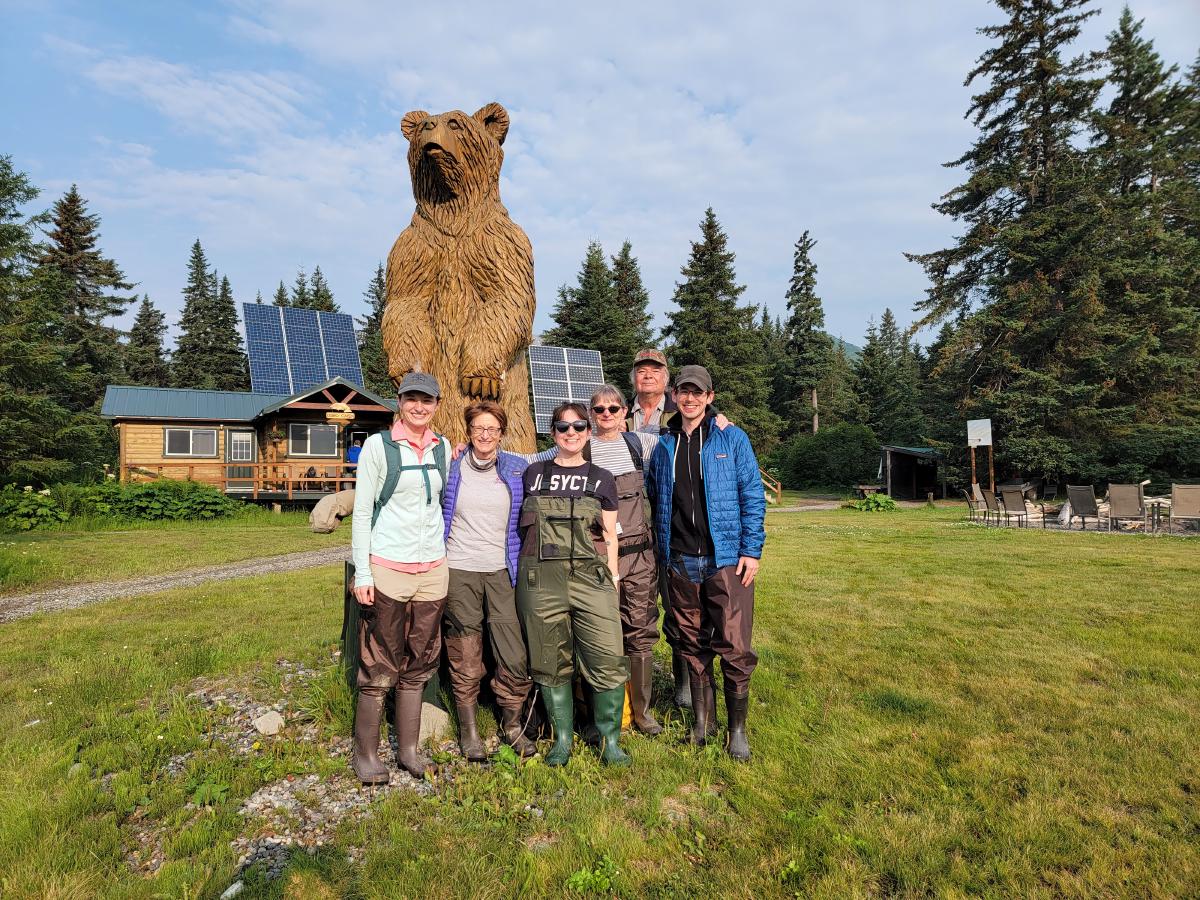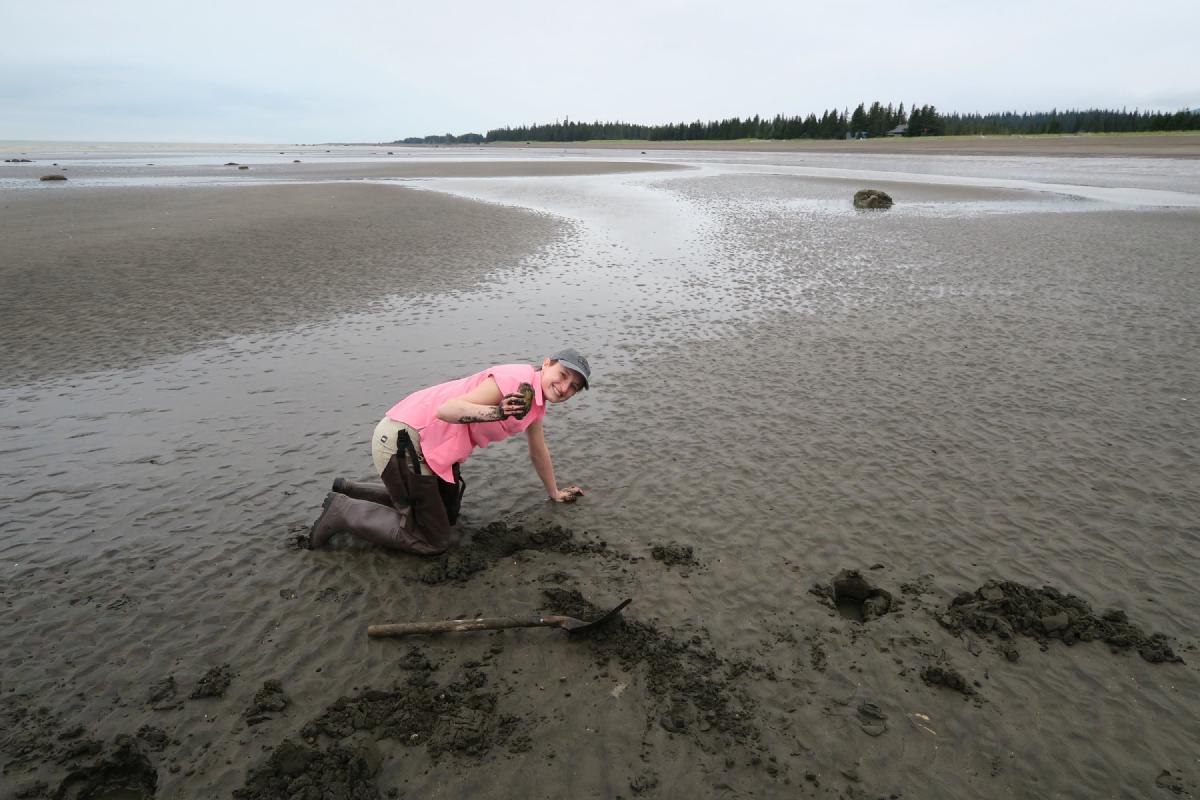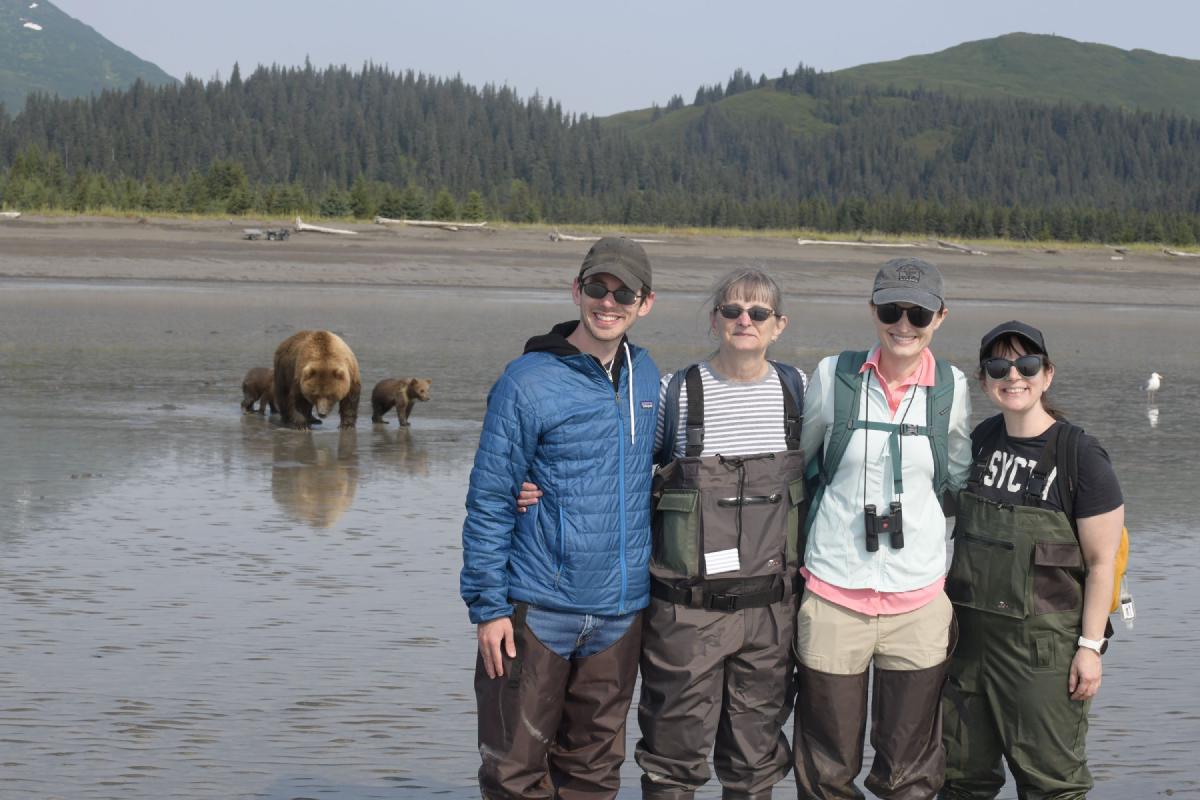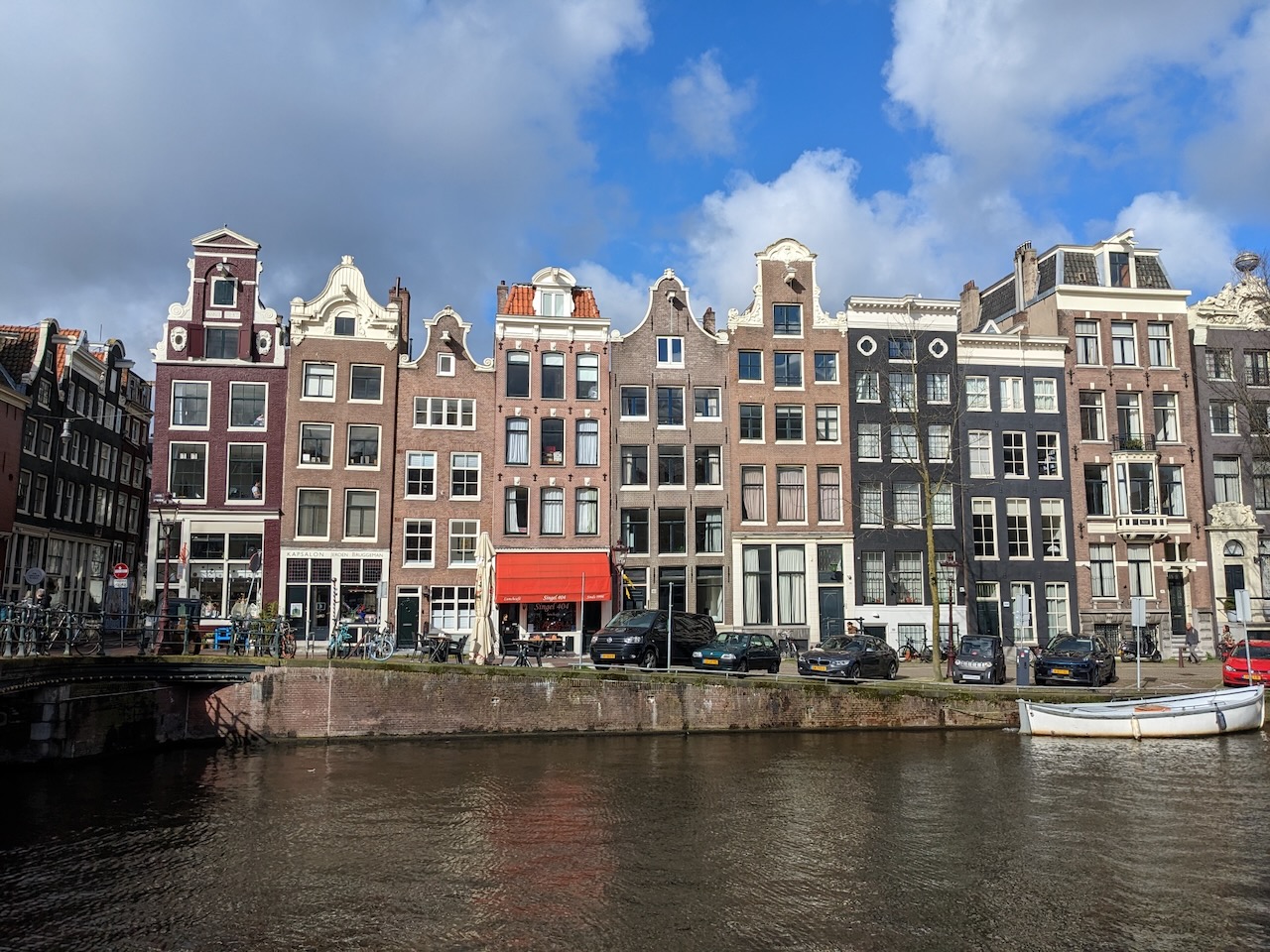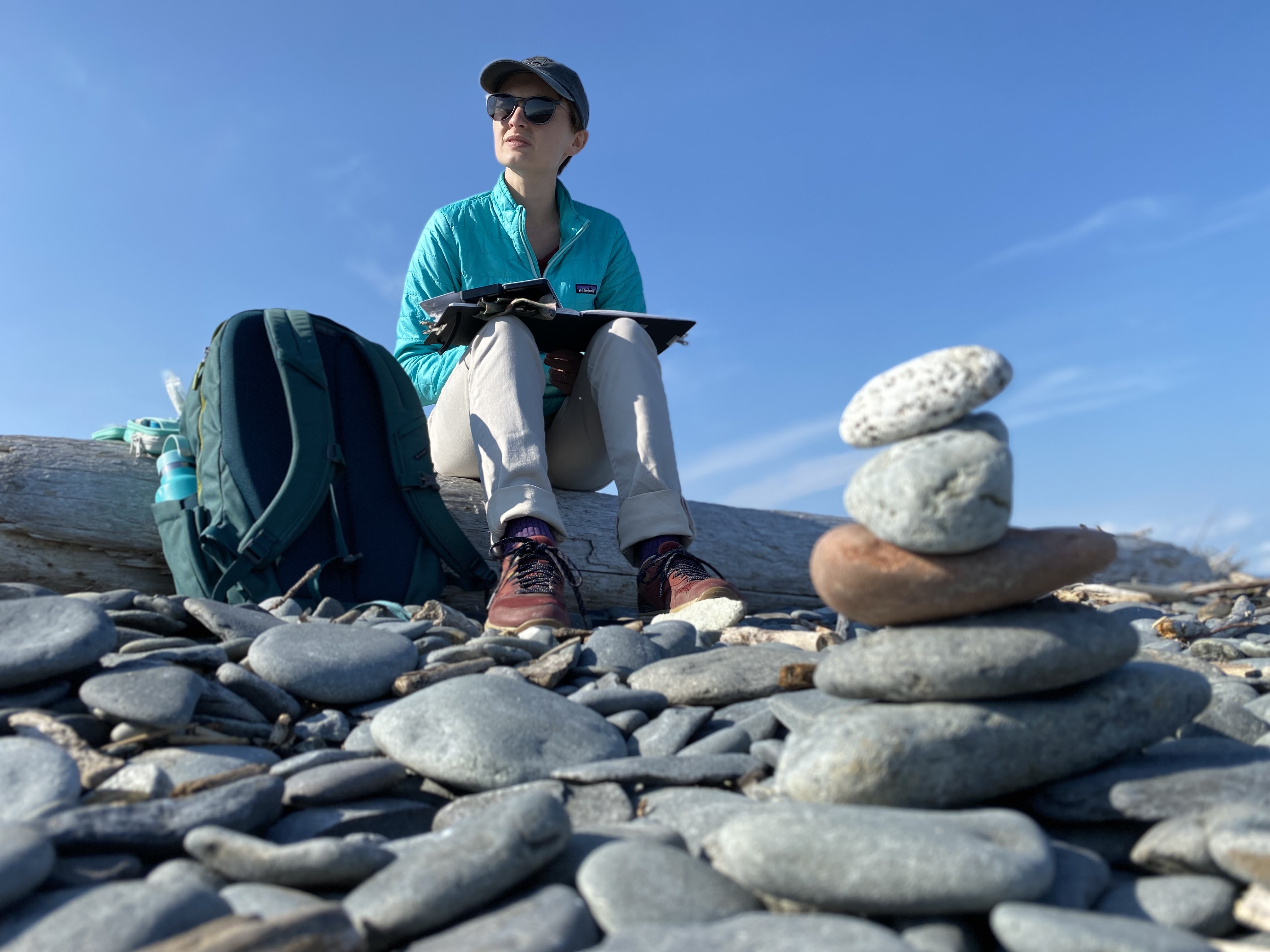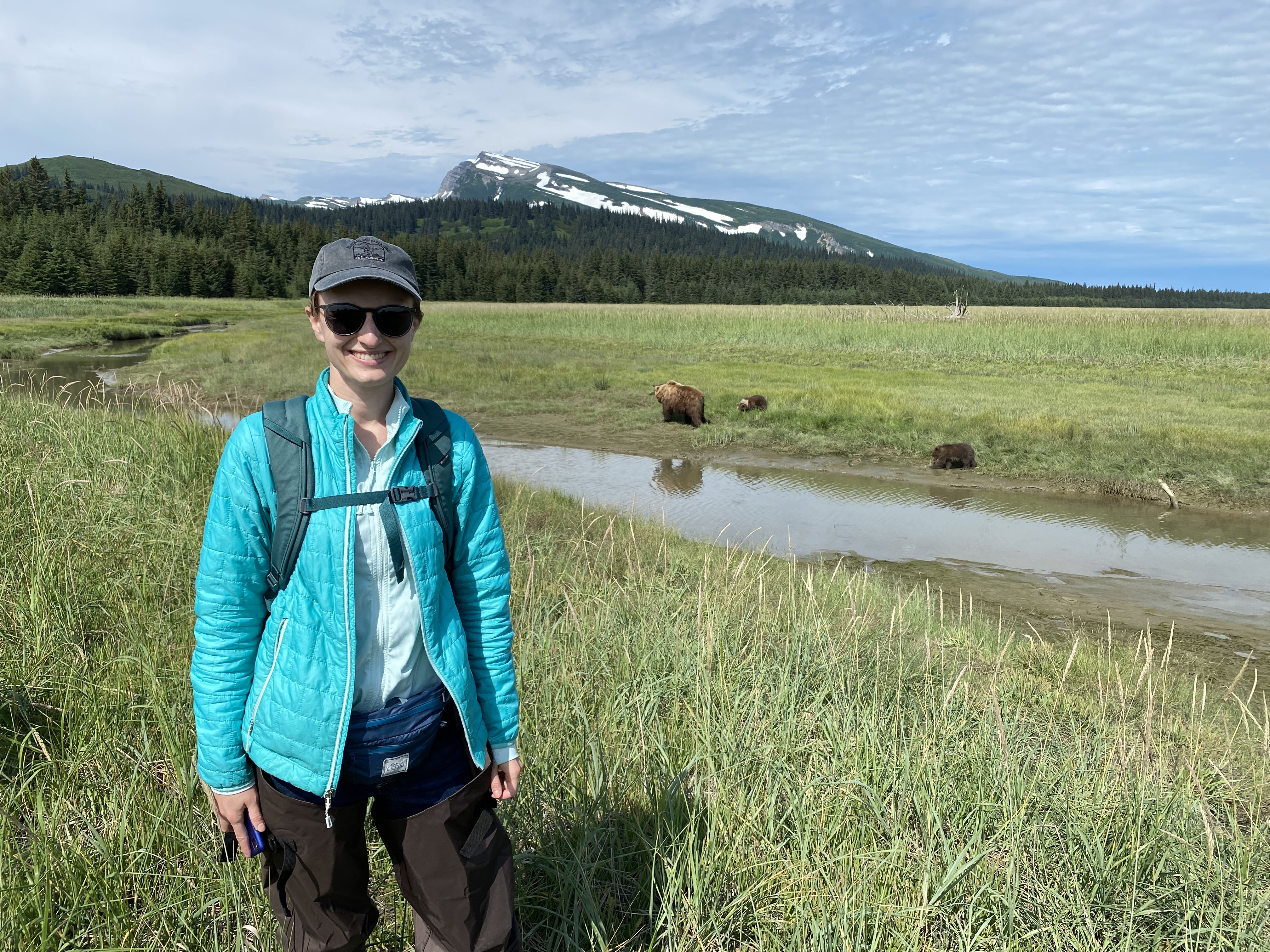
This past July, my family finally made it to Alaska to celebrate my mother-in-law’s birthday. The trip was originally planned for summer 2020, but for obvious reasons it had to be delayed. After visiting Alaska many times with my parents growing up, I was so excited to share this special place with my husband’s family. We took the land route - no cruises apart from a few day trips - and saw more wildlife and stunning scenery than we could have possibly imagined!
Arriving in Anchorage
We flew to Anchorage (via Chicago O’Hare, where I indulged in a delicious Chicago dog during the layover) and met up with Glenn’s mother Kathy and sister Laura, along with my parents who were overlapping with us for part of the trip. Anchorage, while not the capital of Alaska (that’s Juneau), is the largest city by far (about 300 thousand people out of a state population of 740 thousand).
Flying over Wrangell-St. Elias National Park during the descent into Anchorage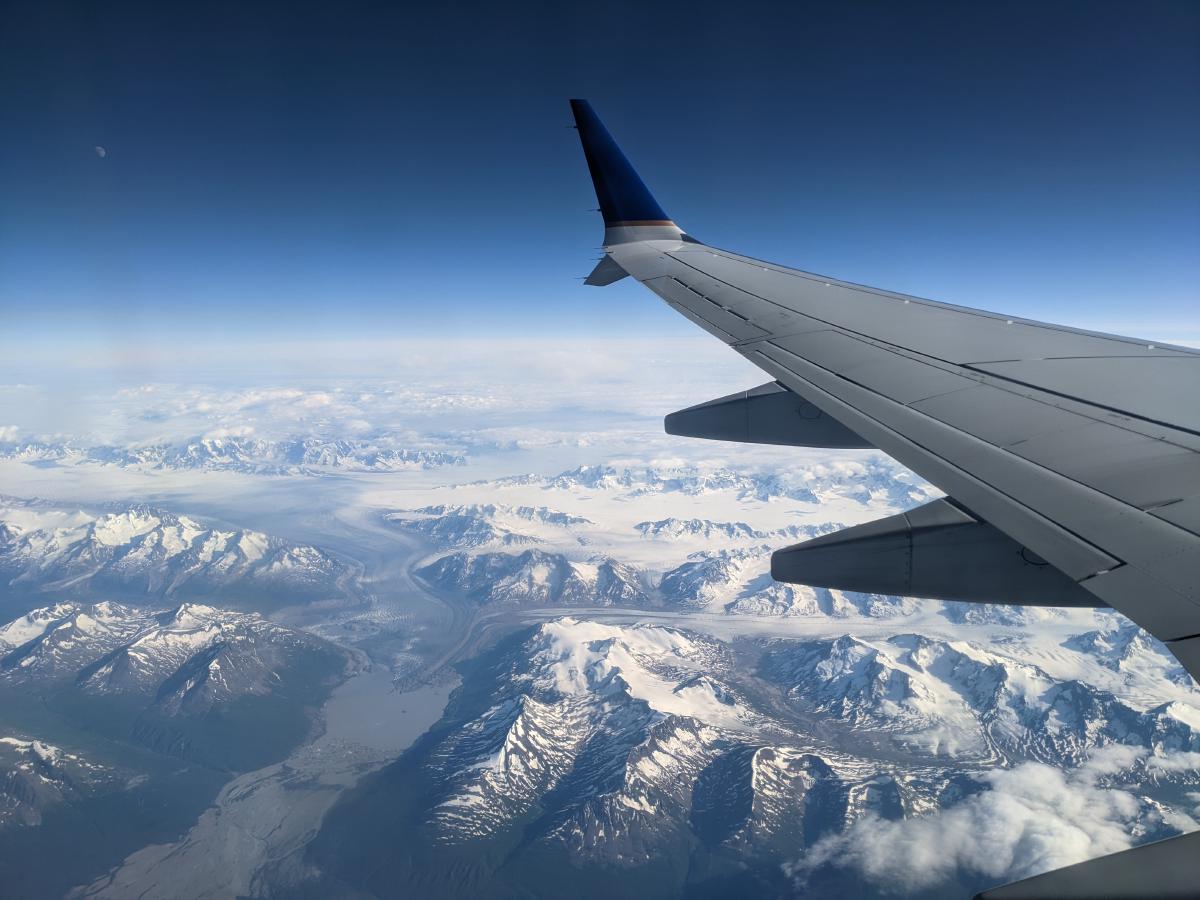
Gwennie’s Old Alaska Restaurant is the best place to eat near the Anchorage airport. They serve breakfast all day, reindeer sausage, grits, and homemade biscuits in a building covered with frontier decor and knickknacks.
Did you know that reindeer are just ranched caribou?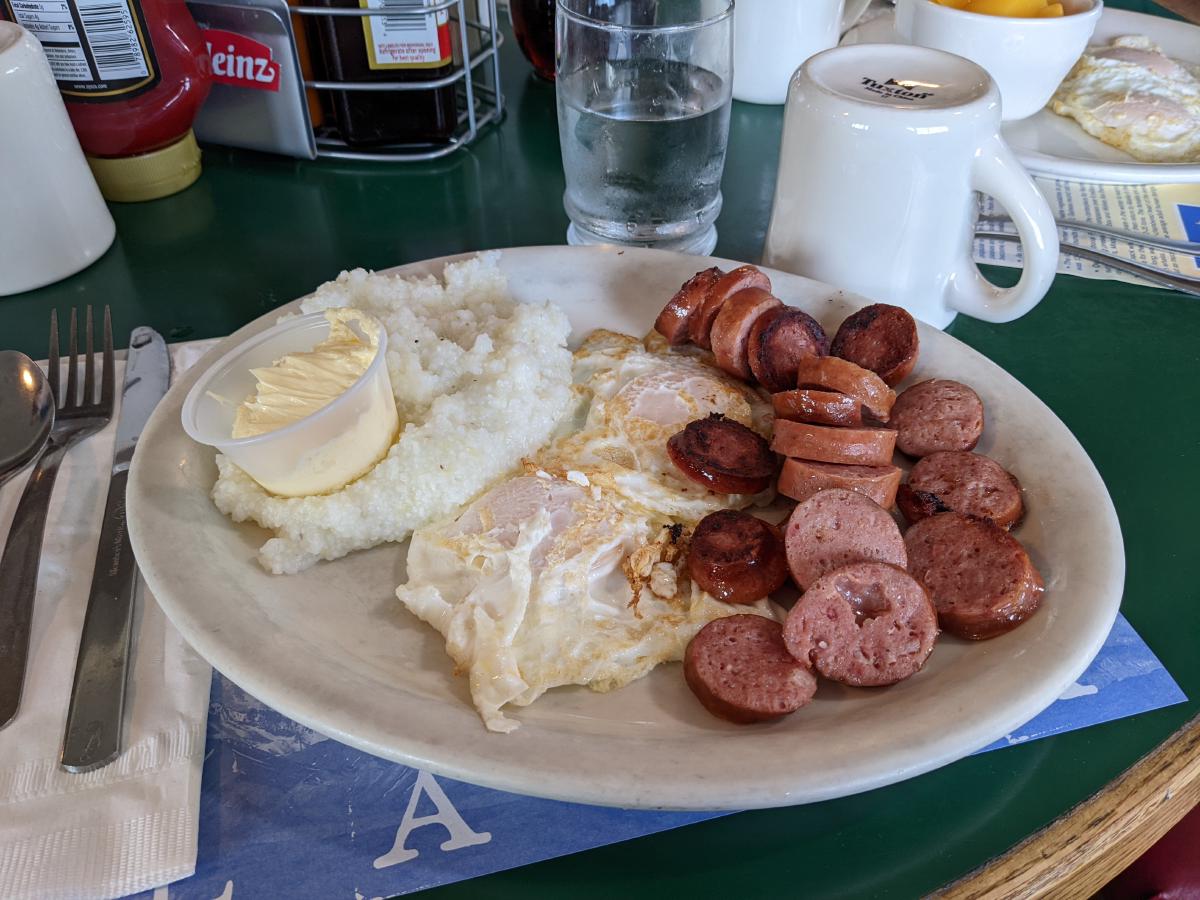
Alaska Native Heritage Center
We wanted to learn more about the Alaska Native peoples, since they are a totally distinct population from the Native Americans of the lower 48 with whom we are more familiar. The Alaska Native Heritage Center taught us about the 5 main cultural groups and their distinct regions and ways of life in the harsh northern climate and terrain. The museum exhibits were presented to show the Native culture prior to Western influences, during the transition period, and then how they are keeping their culture alive in today’s modern world. Some are fishers, others hunt land mammals such as moose or caribou, and those of the far northern reaches hunt whales and seals from the ice floes. Outside, there was a beautiful pond surrounded by replicas of Native dwellings from each of the cultural groups.
The traditional Ulax̂ dwelling of the Unangax̂ people of the Aleutian Islands, covered in blooming fireweed.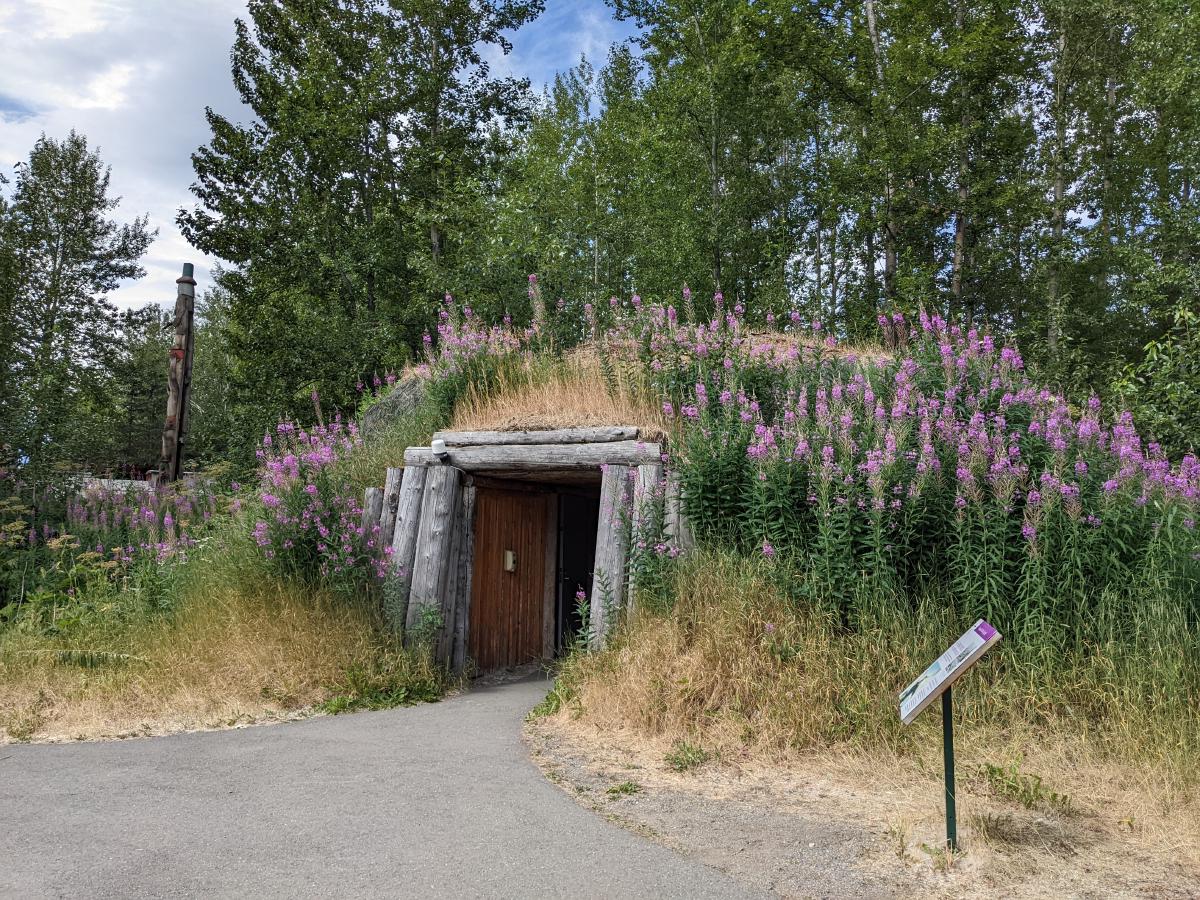
I was fascinated by the community-focused way of life and felt that it was especially relevant in this great time of uncertainty. It’s incredibly important that we come together to create our own support networks and communities. In Texas and much of the rest of America, life has become very individualistic and isolated from community. One buys a house in the suburbsthat is far from gathering places, needs a car to get everywhere because they are surrounded by dangerous stroads (a combination street-road that is very common in the US and is unpleasant for drivers, cyclists, and pedestrians), and has a fence surrounding their property that reduces communication with neighbors. I’ve been reflecting on this way of life a lot recently and have been striving to create my own community of support to bridge this gap. Aren’t we much happier and more fulfilled when we have these connections and learn from others? Isn’t it important to support those who need help and give what we can, knowing they would do the same for us?
Fun fact: Did you know that the bowhead whale can break through ice two feet thick? That would give me quite the headache!
Sea Planes at Lake Hood
Our hotel was just across the street from the Lake Hood Seaplane Base, so we spent the afternoon strolling around the lake and watching seaplanes take off. We even chatted with a woman who was about to take her plane out for a spin.
A sea plane at the Lake Hood Seaplane Base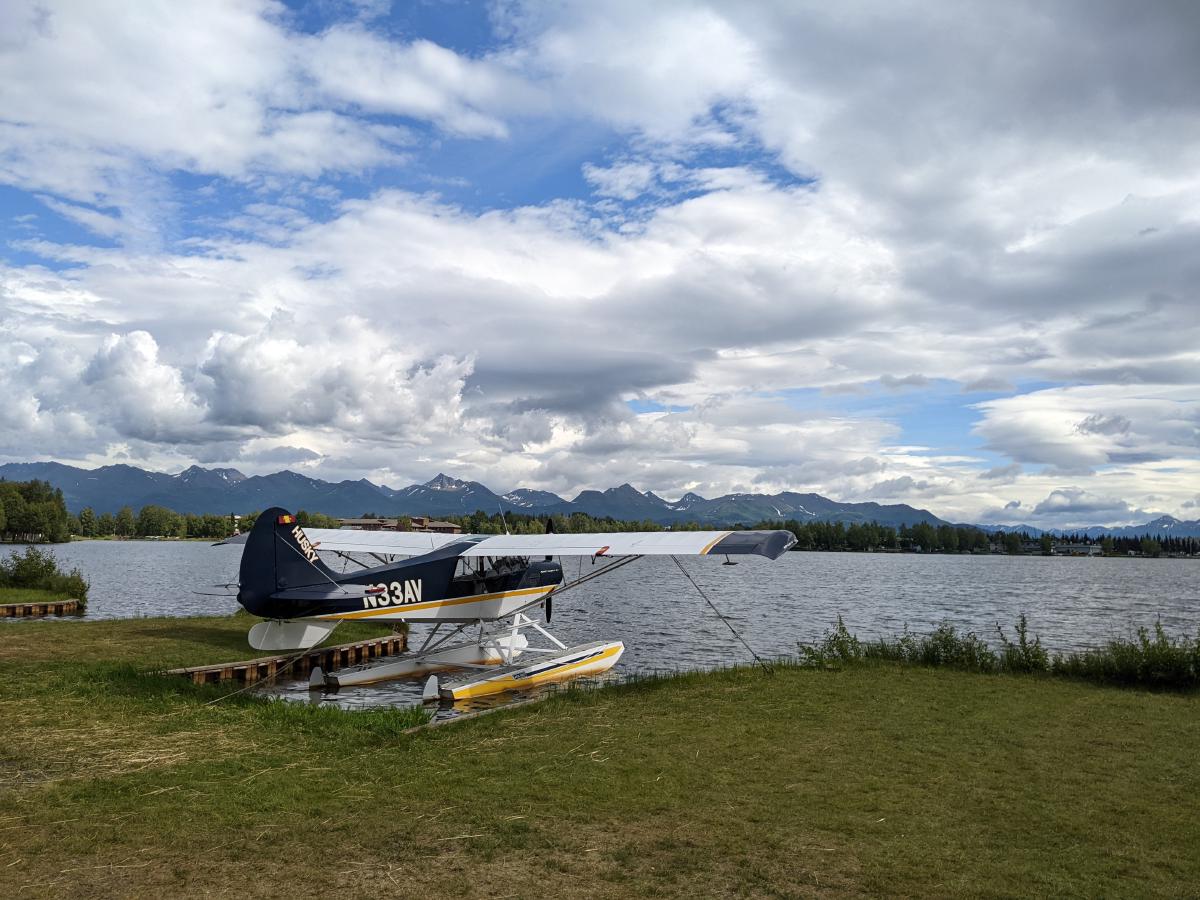
Silver Salmon Creek Lodge
Growing up, I was fortunate to visit Alaska multiple times and always stayed at Silver Salmon Creek Lodge. My dad is a wildlife photographer and for over 20 years he led photography workshops teaching folks how to photograph the brown bears, puffins, and landscapes of Lake Clark National Park and Preserve with the lodge as a home base. The lodge is unique in that the land was purchased prior to the creation of the national park, so it’s the only way to stay overnight in this remote area without camping.
The serene and isolated Silver Salmon Creek Lodge | Image courtesy of Lorrie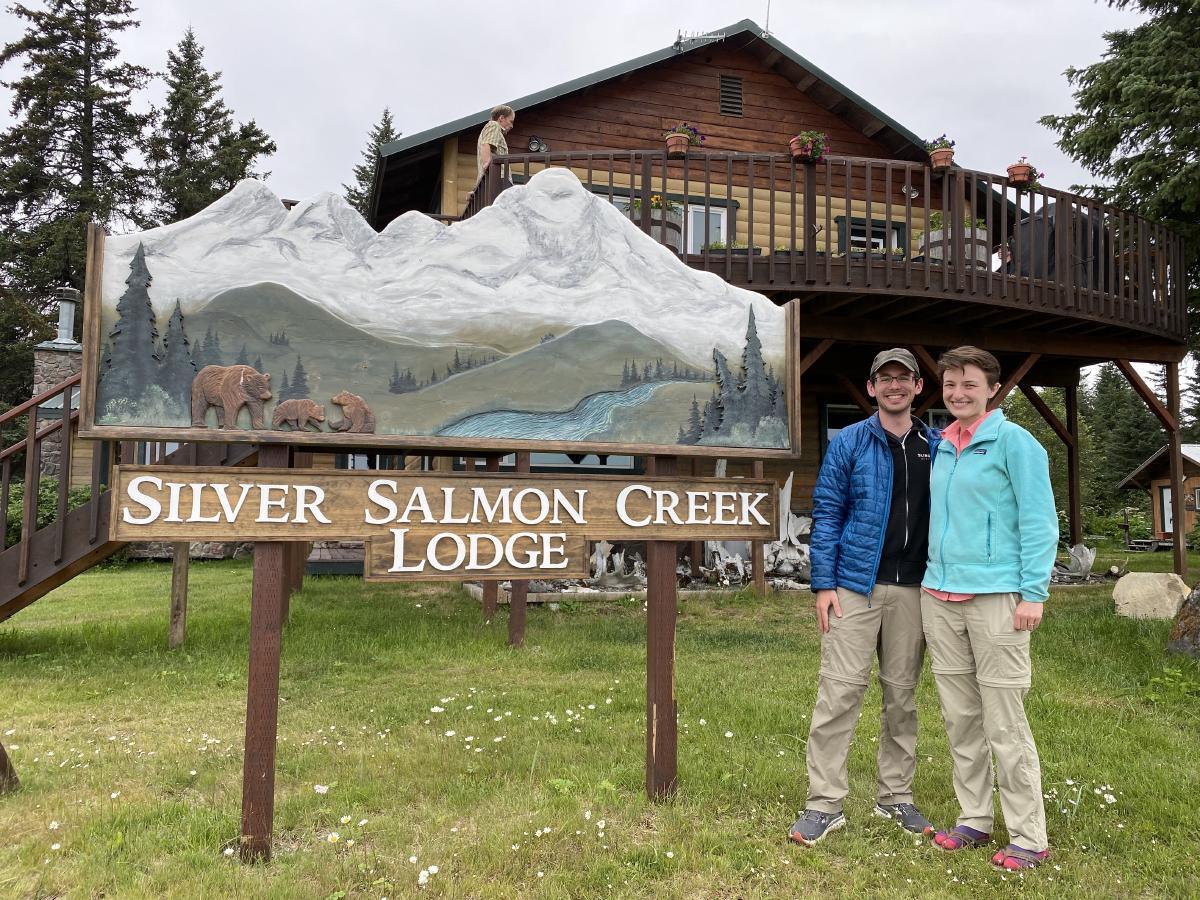
I caught a Silver Salmon when I was 7 - my first and probably my last ever fish catch. I didn’t want to touch it, so my mom held it for the photo. | Image courtesy of Dave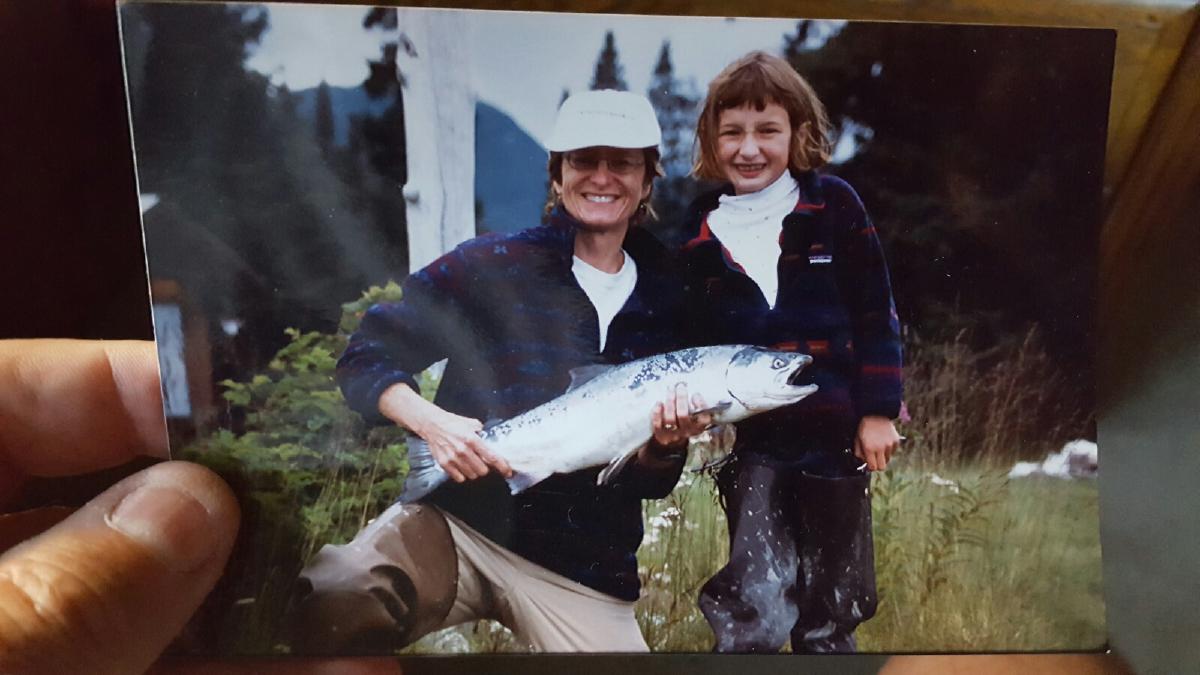
Lake Clark National Park is across the Cook Inlet from the more populated area of Alaska, so reaching it requires a small plane flight that lands on the beach during low tide (it’s a 20+ foot swing some days). We flew in a De Havilland Beaver from 1954! On the flight in, our pilot took us past Mount Iliamna, an active volcano behind the lodge. The air is so fresh, and the terrain is lush green coastal plains butting up against a thick evergreen forest and mountains.
Mount Iliamna as seen from the plane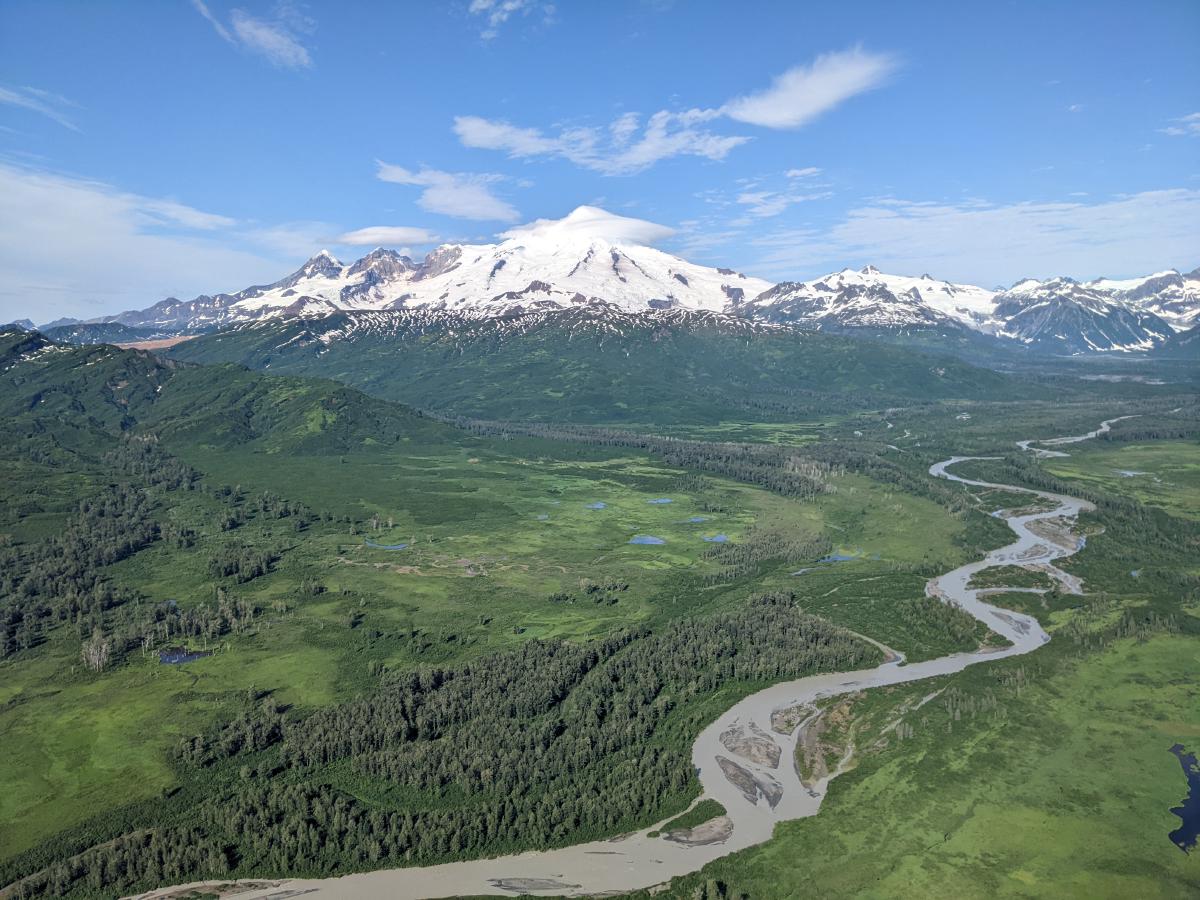
Landing on the beach at low tide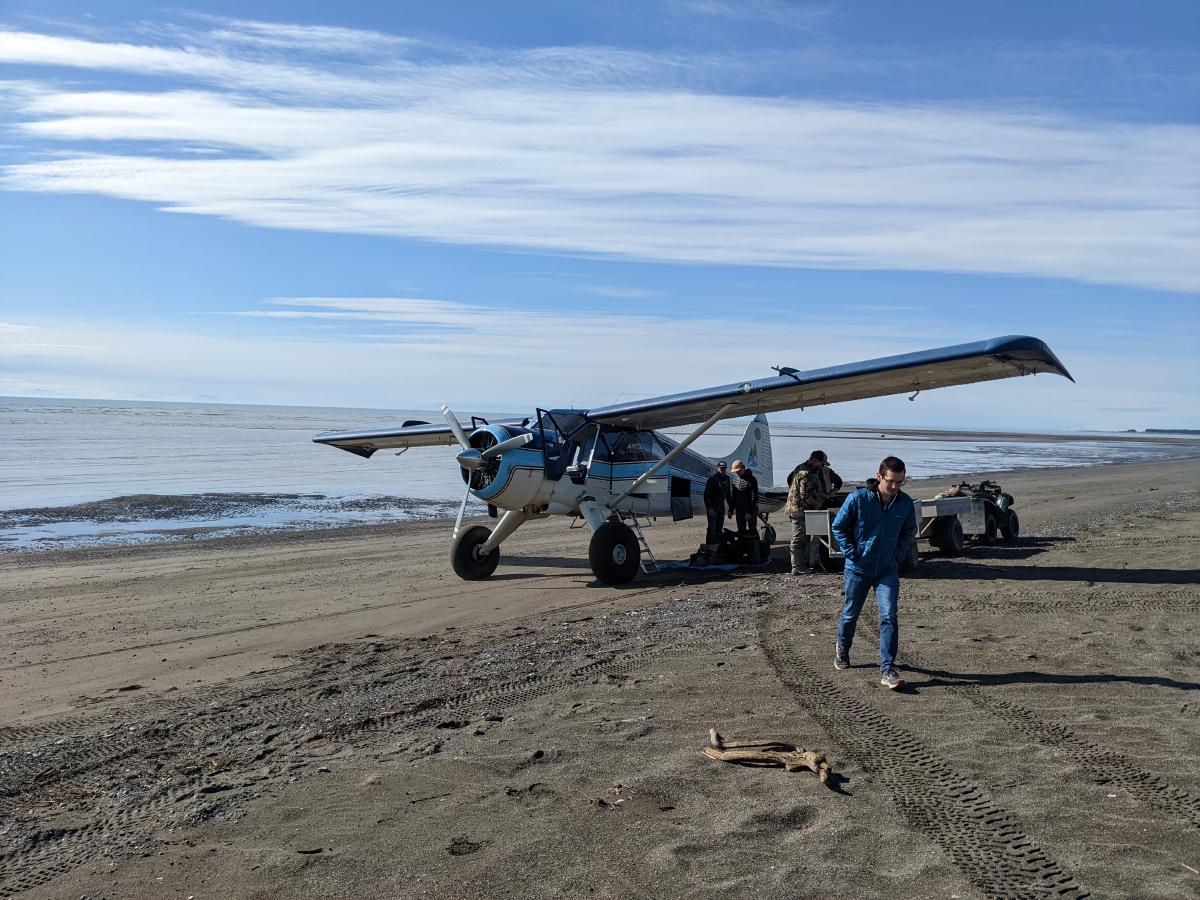
Even though I hadn’t visited the lodge in over 11 years, it felt like coming back home. David, the owner, is incredibly welcoming and remembers every guest that has ever stayed there. All the staff was friendly and ran a tight ship with homemade gourmet food (salmon, halibut, gardened lettuce, breads, soups, and cookies). The lodge is so remote that it’s necessary to make pretty much everything from scratch if it’s not brought in as part of the supply runs by boat or small plane.
Coastal Brown Bears
Disclaimer: We saw these bears with an experienced guide. Additionally, the bears in Lake Clark National Park are adjusted to being around people, are not hunted, and have access to plenty of food (grass, clams, berries, salmon), so we were able to be fairly close as they do not perceive people as a threat. Do not get this close to bears anyplace else and always have a guide!
Posing with Slope Mountain in the background - do you see the bear? | Image courtesy of Glenn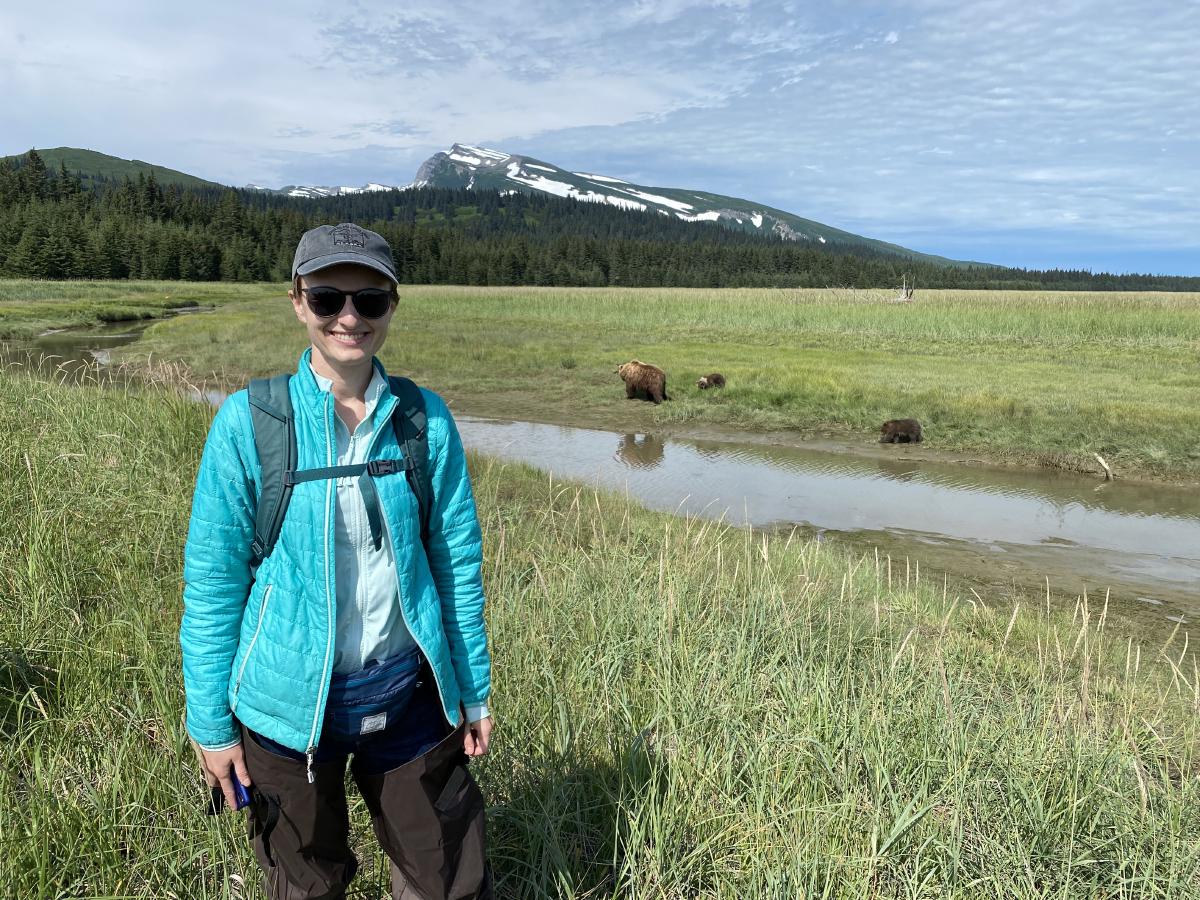
The main highlight of the lodge is the opportunity to see coastal brown bears (part of the same family as grizzly bears) up close and in the wild. We donned hip boots and chest waders (I prefer the hip boots for the maneuverability), hopped into the trailer of an ATV, and drove out on the park’s trails to view bears in the grass. Our guide, Robb, explained the safety precautions required. Don’t leave a bag in the ATV - if the bear gets it, it’s now the bear’s bag. Stay upwind of the bears to avoid surprising them with our scent. Move in a small clump rather than spreading out to reduce disruption of the bear’s environment. We quickly found a mother bear (Agro) and three spring cubs (just a few months old) who were playing in the grass and crossing the slough. We loved watching the cubs play and even got to see them nurse!
I only had my phone camera for this trip. I’ve taken plenty of Alaskan wildlife photos in the past with a DSLR (you’ll see some in this post). This time around, I wanted to focus on being in the moment and sketching rather than photographing.
An adult grizzly bear standing in the grassy tidal marsh | Taken in 2011 Bear cubs play-fighting | Taken in 2011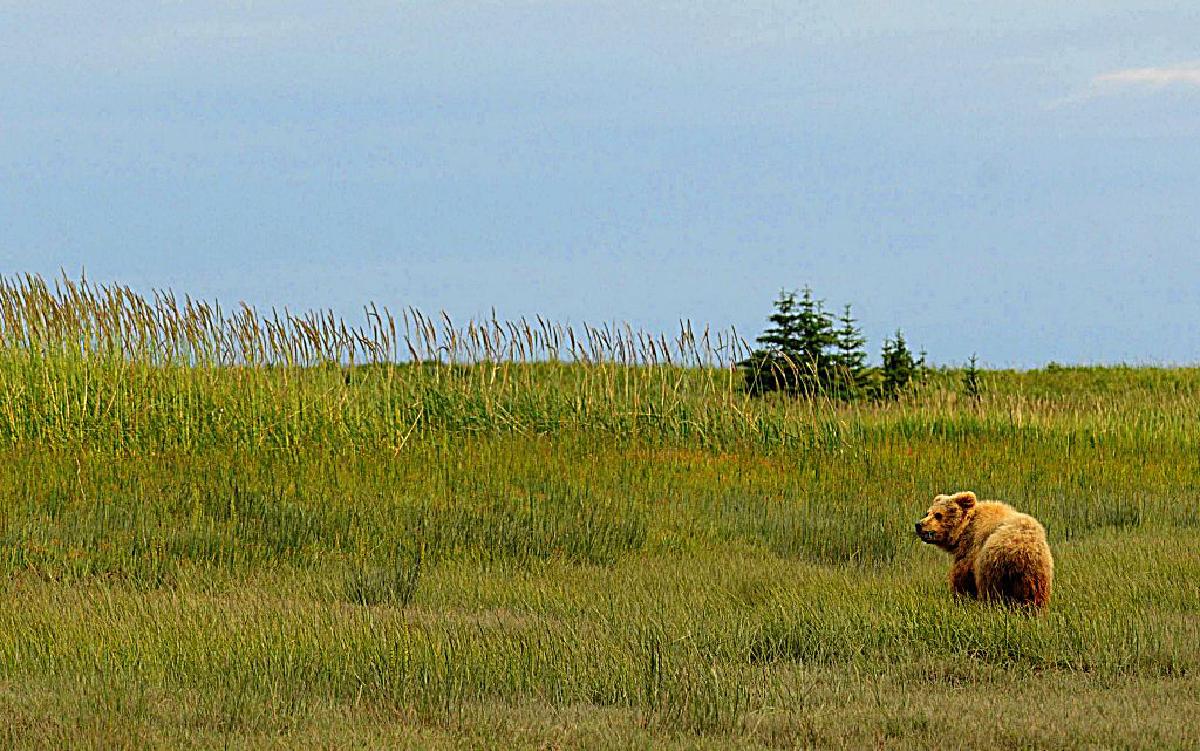
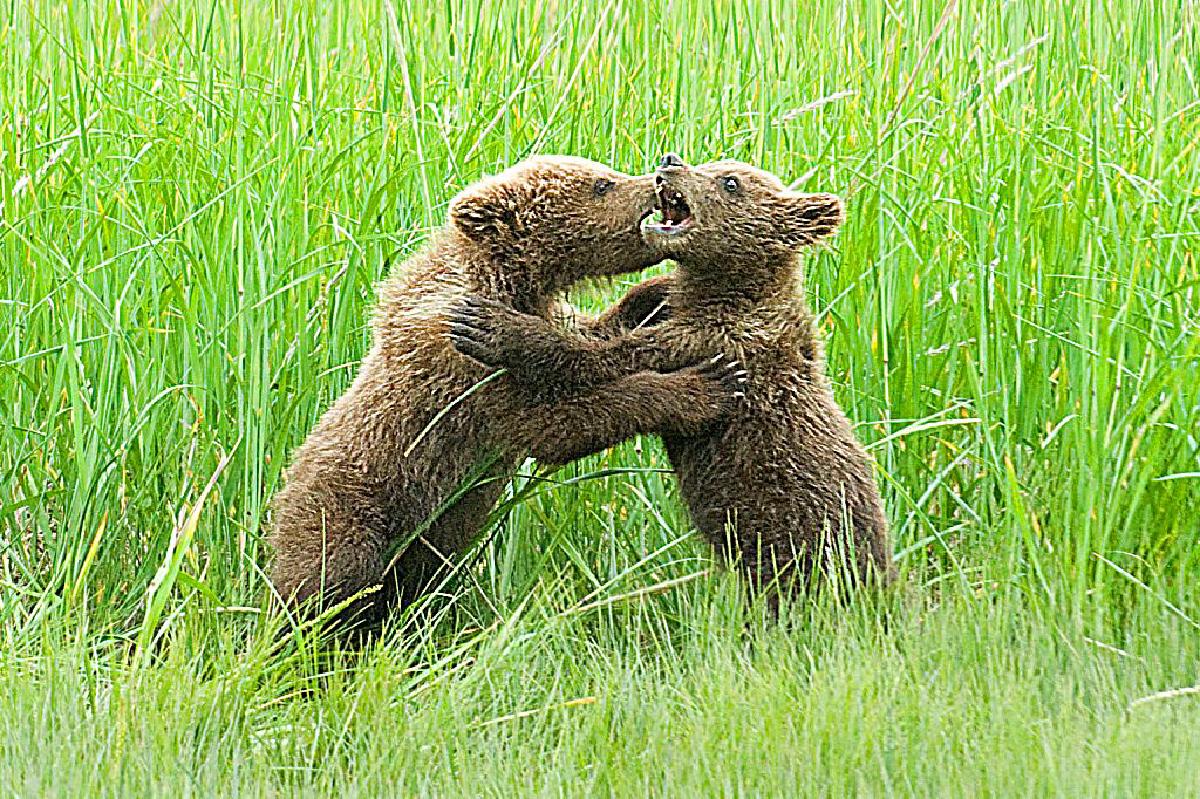
Over the three days, we saw over a dozen unique bears, including mothers and year-old cubs, big boars, some lone juveniles, and the tiny spring cubs. It was truly an incredible experience!
Boat Trip to Puffins and Fossils
One afternoon we took a boat ride out to Duck Island, the easternmost point of the Alaska Maritime National Wildlife Refuge (whose visitor center is far across the water in Homer). The Refuge encapsulates islands all along the Aleutian chain that stretches out to the East from Alaska. My mother-in-law’s bucket list item was to see puffins in the wild, and I crossed my fingers for the entire boat ride hoping that there were as many puffins as I remembered from my childhood. Thankfully, we were not disappointed.
The boat we used for the day trip - Stormy Skye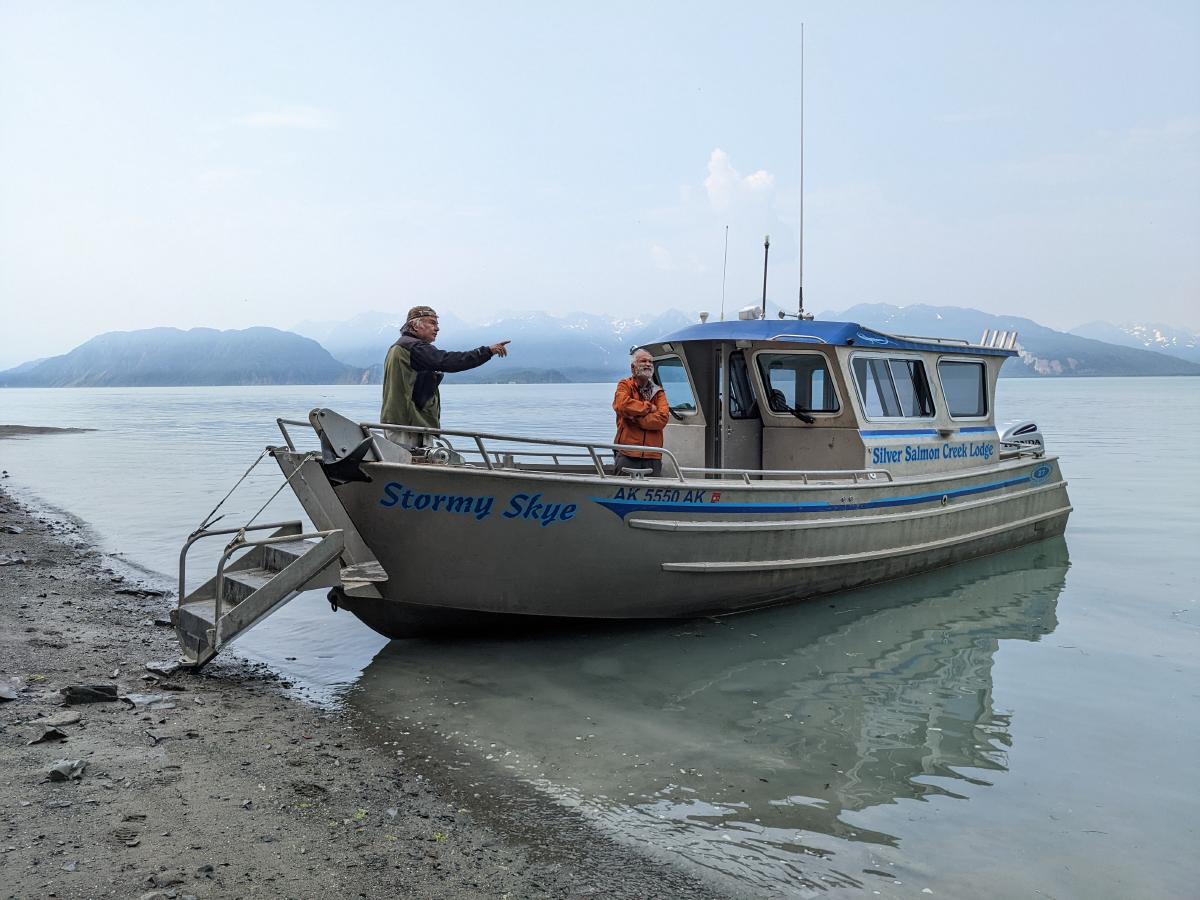
The cliffs of the island were absolutely covered in the derpy birds, primarily horned puffins. We saw them jump off the cliffs, fly out over the water flapping their wings frantically (they are not very good at flying, but are excellent swimmers) and amusedly watched them try to land back on the cliffs without crashing. They flew right by our heads!
Horned puffins have a lot of trouble flying! | Taken in 2011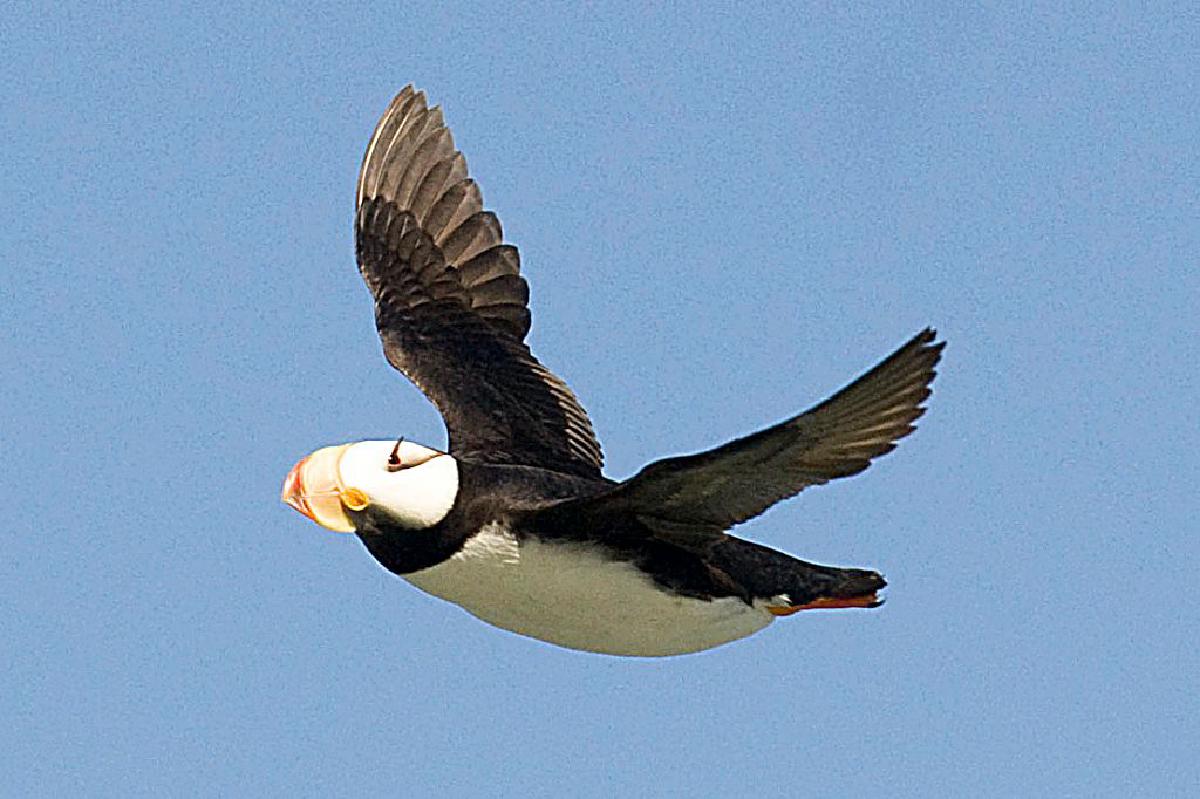
After watching the puffins for a while, we boated around the corner to Fossil Point, an area where the rock face has broken away to reveal Jurassic-era fossils of clams and ammonites (ancestors of nautili). Some of them were enormous! We did not take any fossils (it’s part of the National Park, plus we should leave them for others to find) but really enjoyed discovering them in their natural habitat.
The edge profile of an ammonite fossil An impression of an ammonite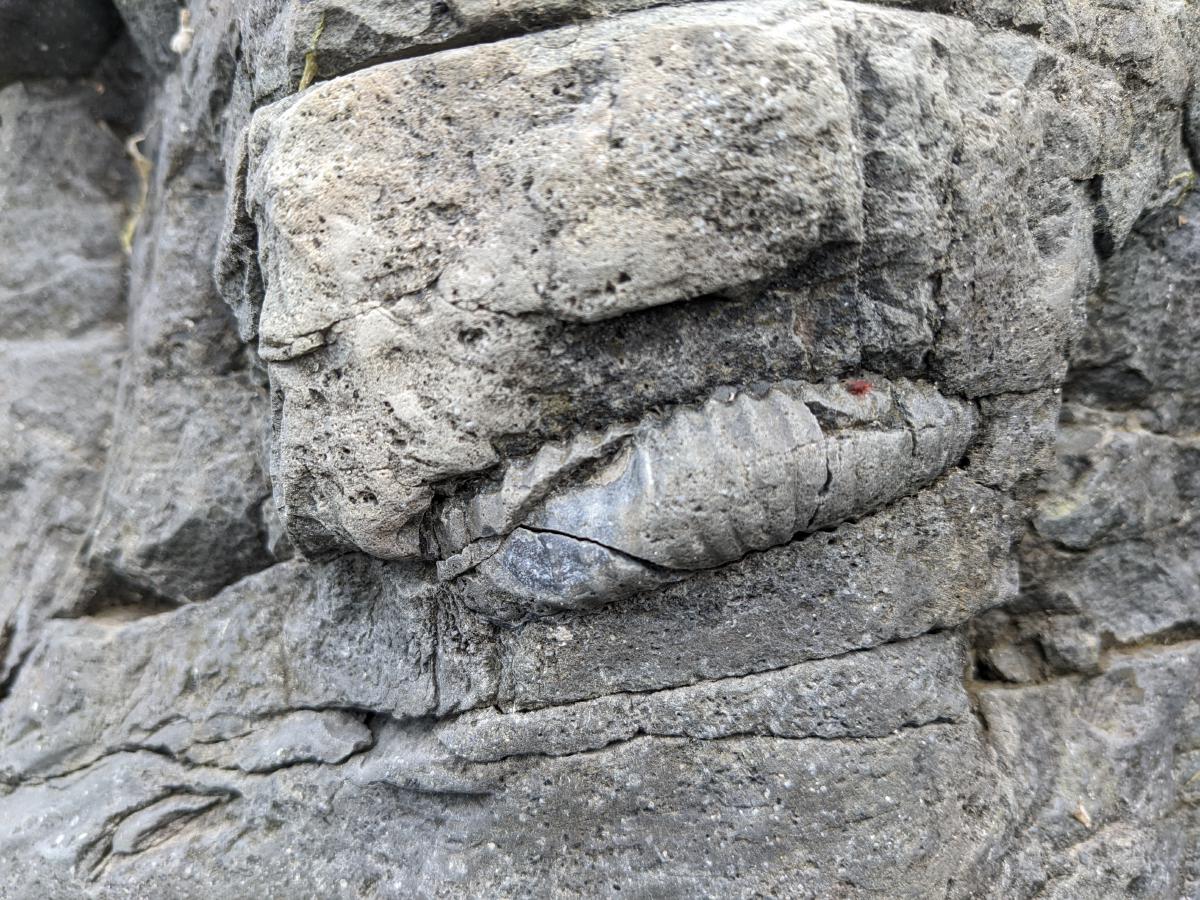
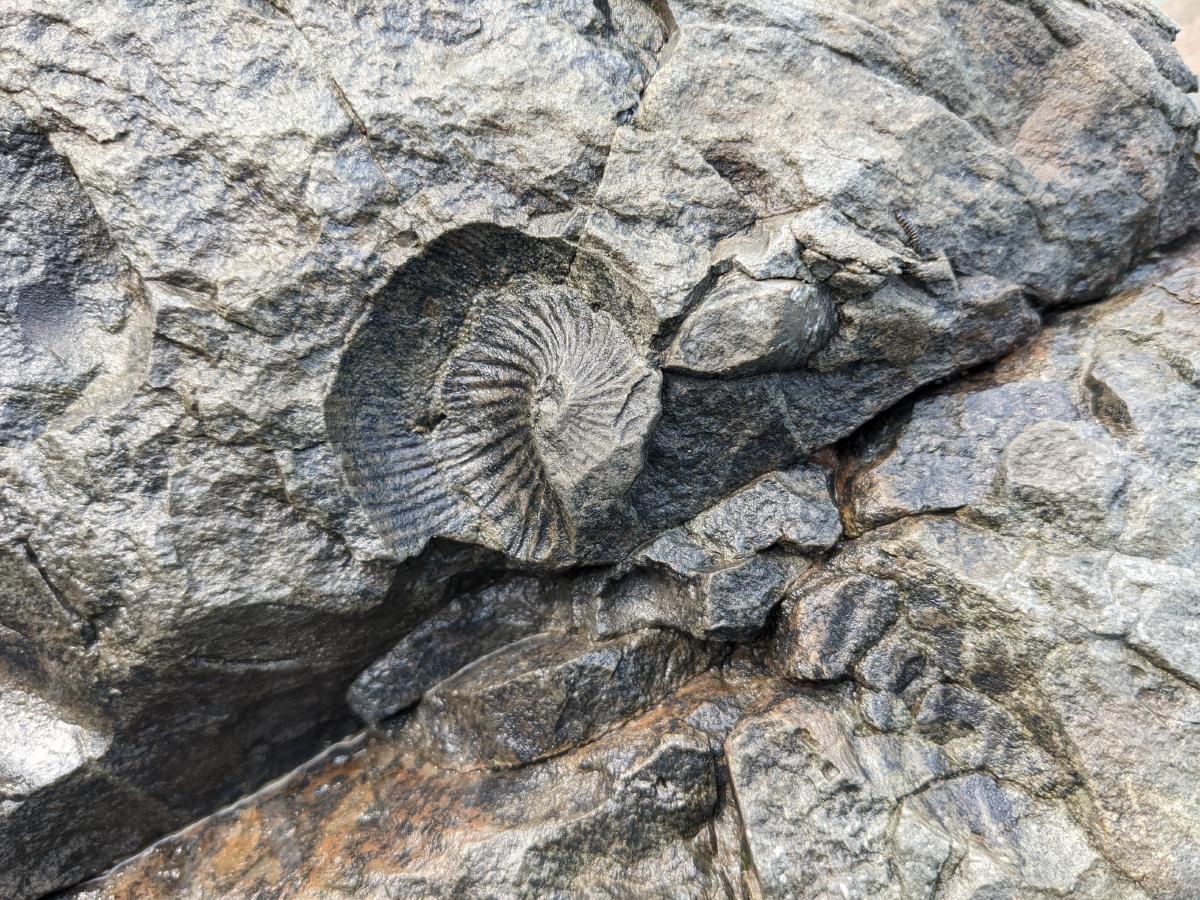
Lilies on the Lake
On our final afternoon at the lodge we took an ATV ride through the mosquito-infested forest to Silver Salmon Lake. Once out on the water, we were surrounded by lily pads and the gorgeous yellow-orange flowers of the Spatterdock Yellow Waterlily. The water was as smooth as glass as we glided past the pads, viewed a beaver dam (and caught sight of the beaver in the water), and even saw a swan and a few black bears in the distance. This lake is where the silver salmon (also known as coho salmon) are born and is also where the adults return to lay their eggs and spend their final days before they perish and fertilize the lake with their bodies. They spend most of their lives in the ocean, making only one round-trip journey down and up the creek during their lifetime.
It was incredible how quiet it was on this lake, so far from civilization. The flowers of the Spatterdock Yellow Waterlily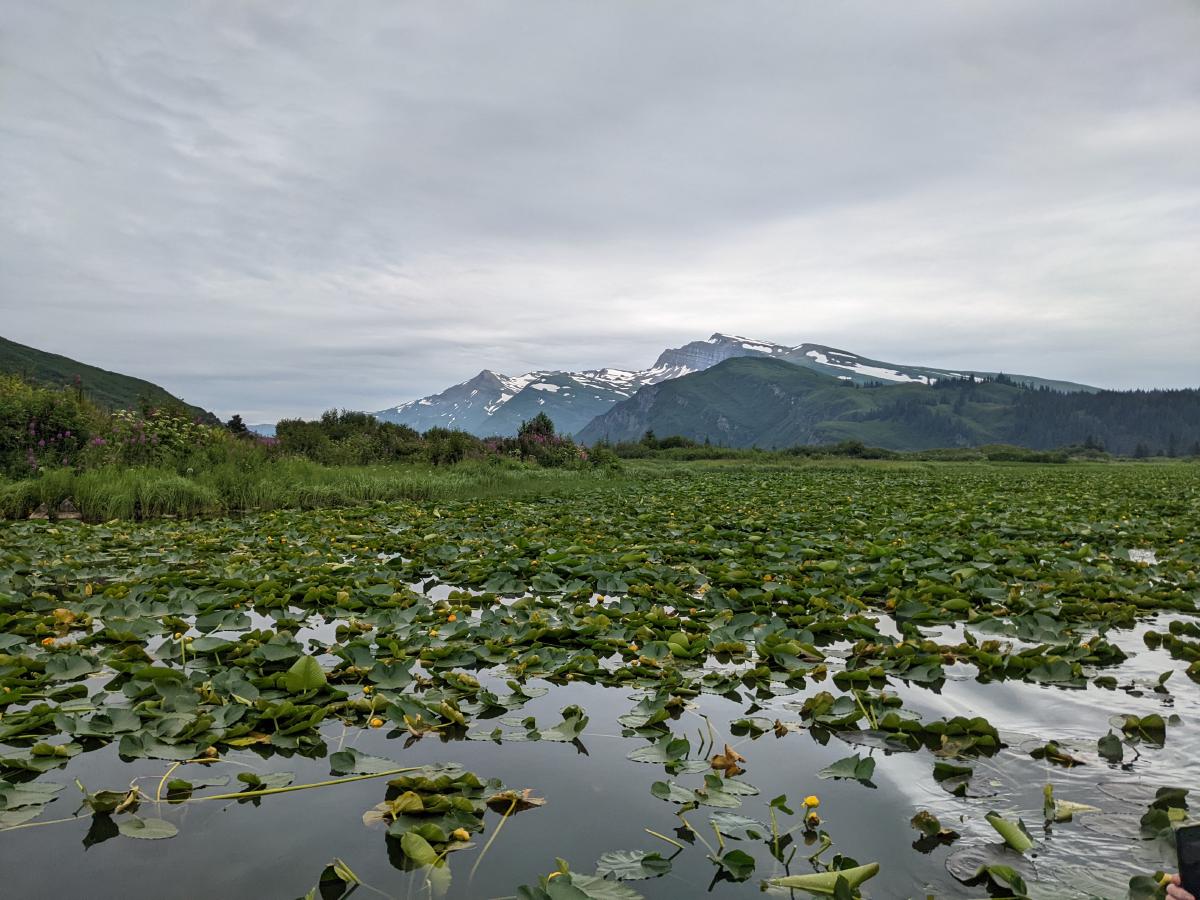
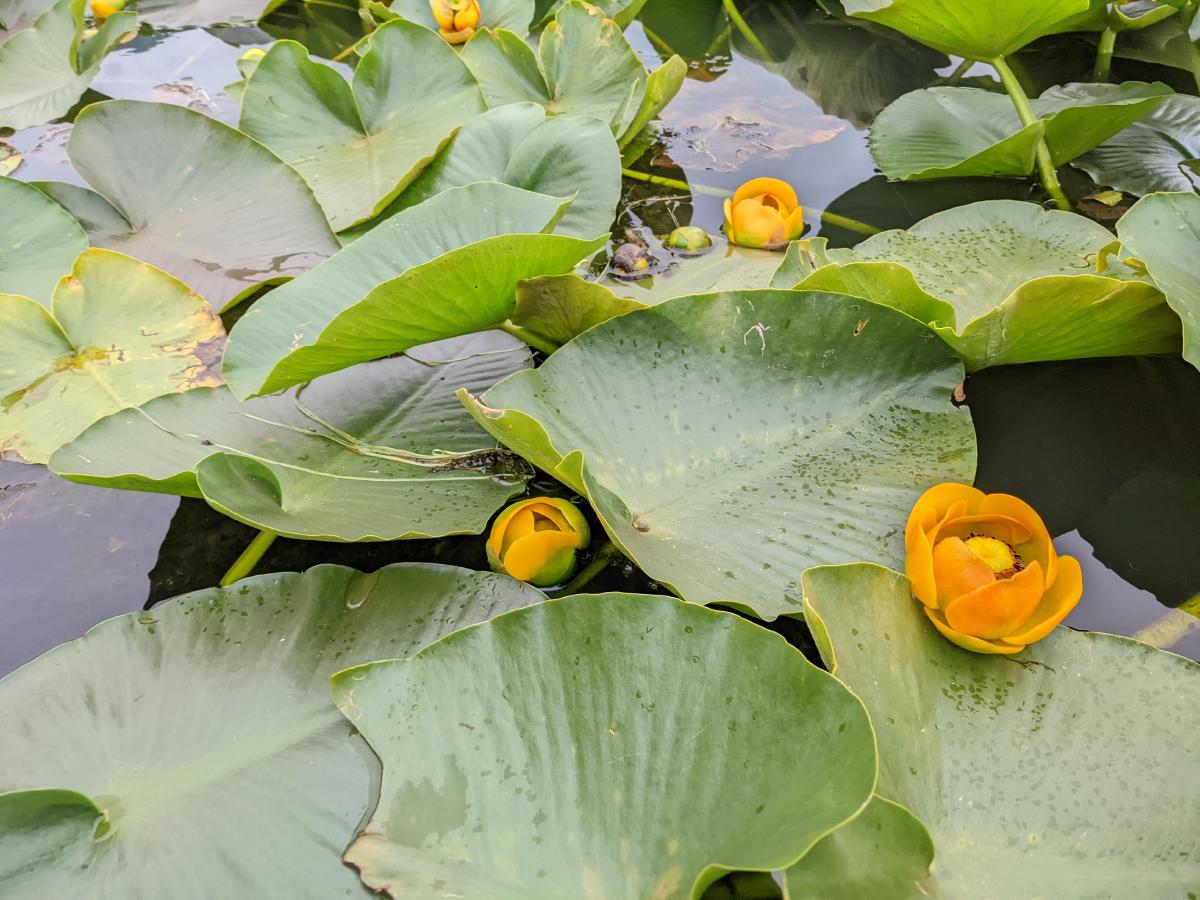
Clamming and Bears on the Beach
One of my best childhood memories from the lodge was clamming on the beach surrounded by brown bears. Luckily, there was a low enough tide one day, and we had the opportunity to dig for Pacific razor clams. They reside in the clam bed of sand and mud out on the flats, and when the tide is low, one can look for an air bubble and start digging. Once a clam has been disturbed, it immediately starts to dig down to escape, so it requires constant upward pulling, a firm yet gentle grip (mine was excellent from bouldering) to avoid breaking the shell, and a little bit of wiggling to loosen the clam’s suction. Later that evening, Robb and Laura fried up the clams for a delicious snack. They were so fresh and succulent that no other fried clam will ever compare.
It’s times like these where the hip boots are exceptionally handy. | Image courtesy of Dave
A Pacific razor clam up-close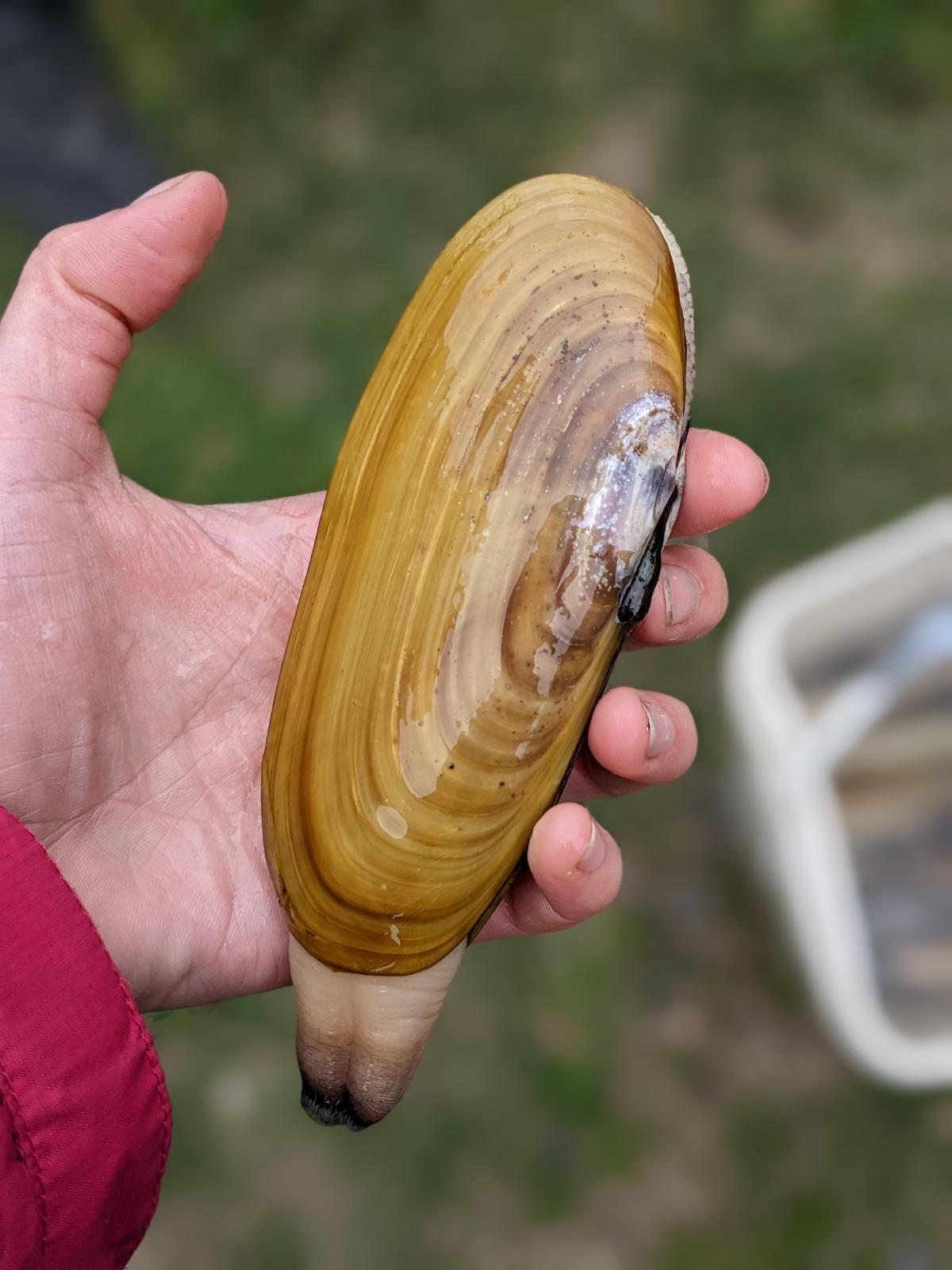
The final evening, we went out after dinner (thanks to the incredibly late sunset providing endless daylight) and just watched bears clamming on the beach. At one point, there were 14 bears on the beach with us.
Observing Agro and her cubs on the tidal flats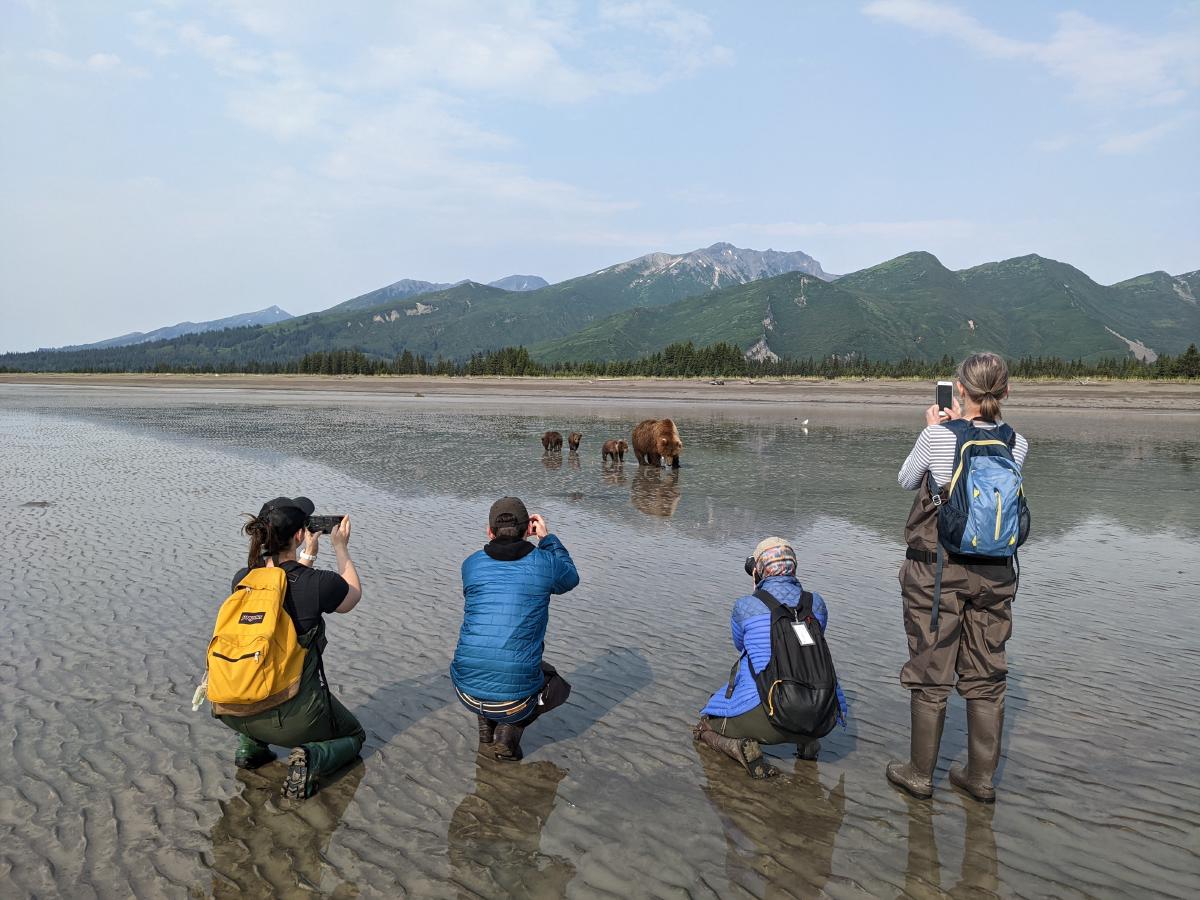
Kathy watching the bears on our final evening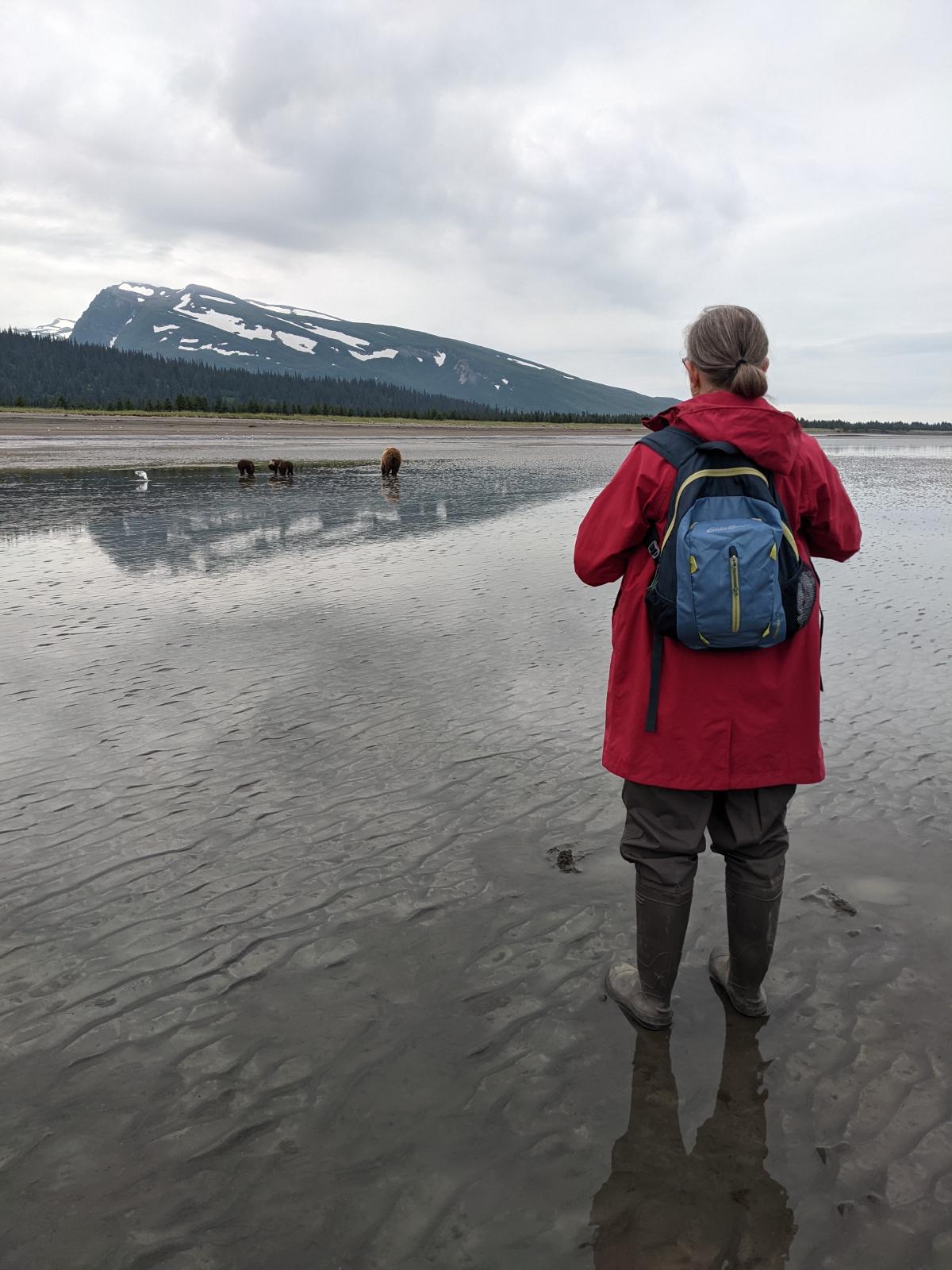
We had such an incredible three days at the lodge. Everyone had the best sleep of their lives - the air was cool and fresh, and it was entirely quiet - no buzzing power lines or electronics to invade one’s mind. I’m so thankful that I had this opportunity to share the lodge with my husband’s family and that we could create some memories of our own.
A trio of spring cubs on the lookout | Taken in 2011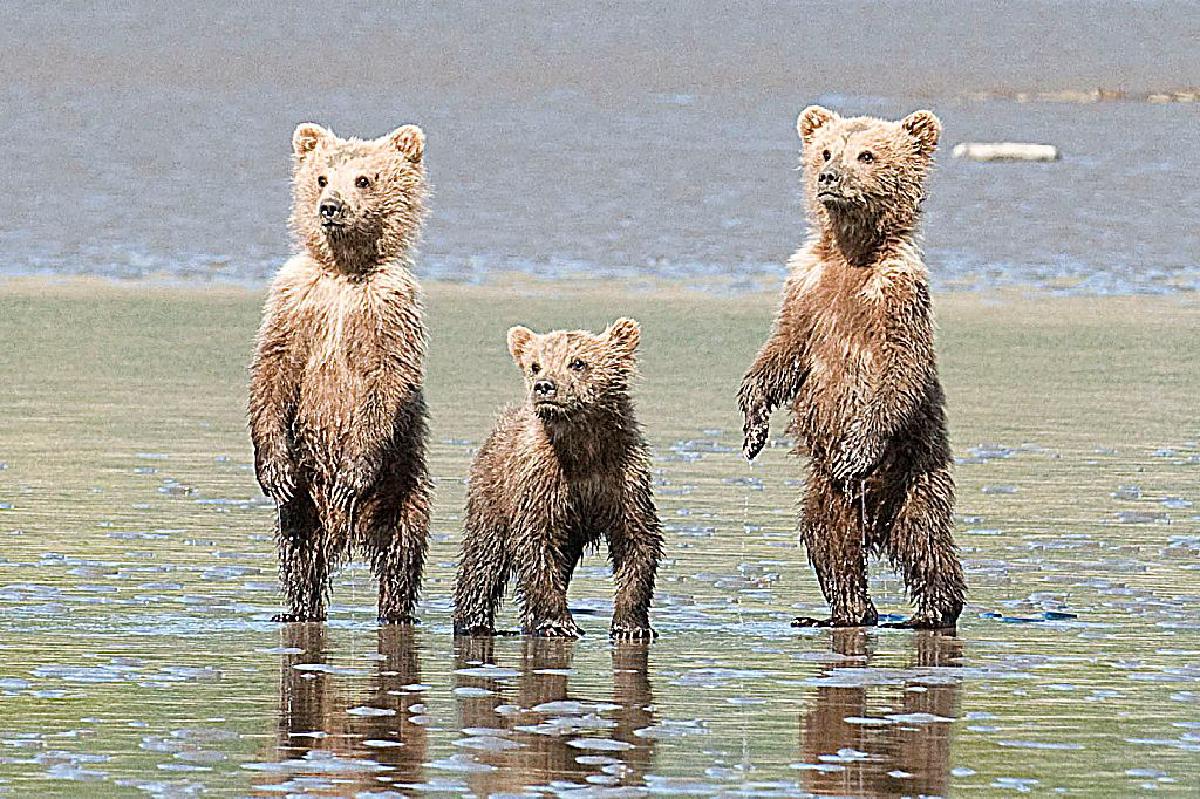
Homer
We wore noise-canceling headsets to be able to communicate during the flight | Image courtesy of Glenn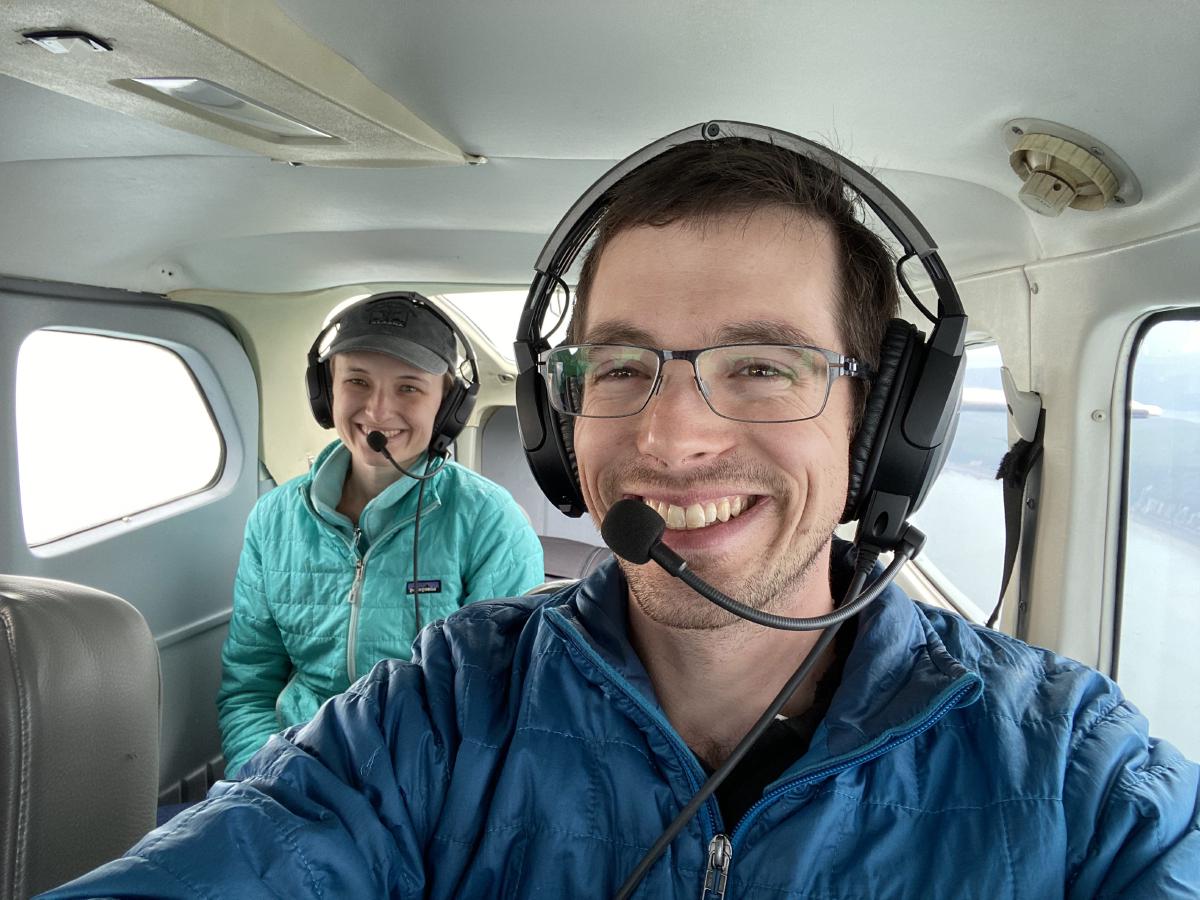
We flew out of the lodge and landed in Kenai, where we rented a car and drove down the coast to Homer. We stayed at the Lands’ End Resort at the very end of the Homer Spit, a skinny 4-mile long peninsula that juts out into Kachemak Bay. I spent a lovely afternoon painting the view and practicing rock skipping from the beach’s endless supply of perfect specimens.
I think I look pretty cool in this picture! | Image courtesy of Glenn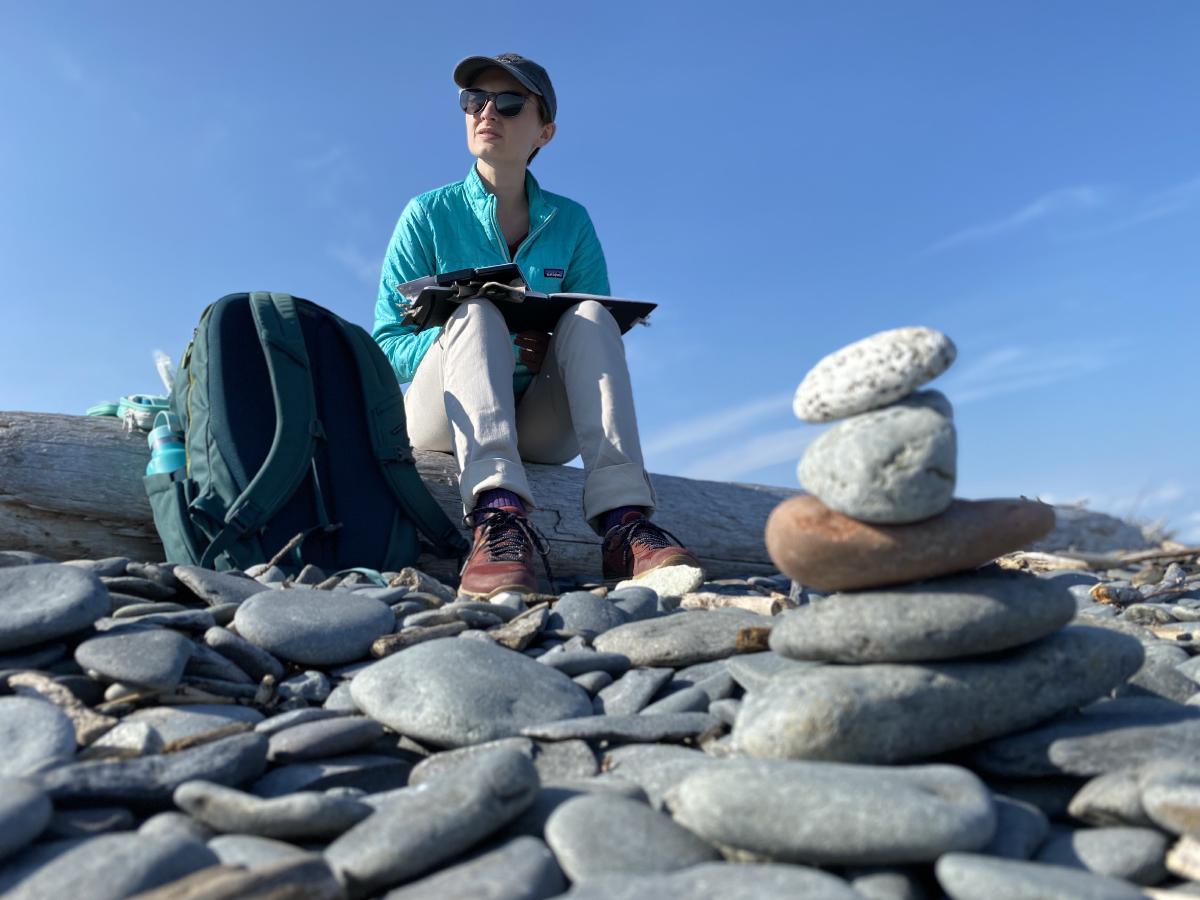
The harbor in Homer at high tide - it looks very different at low tide when the water is 20 feet lower.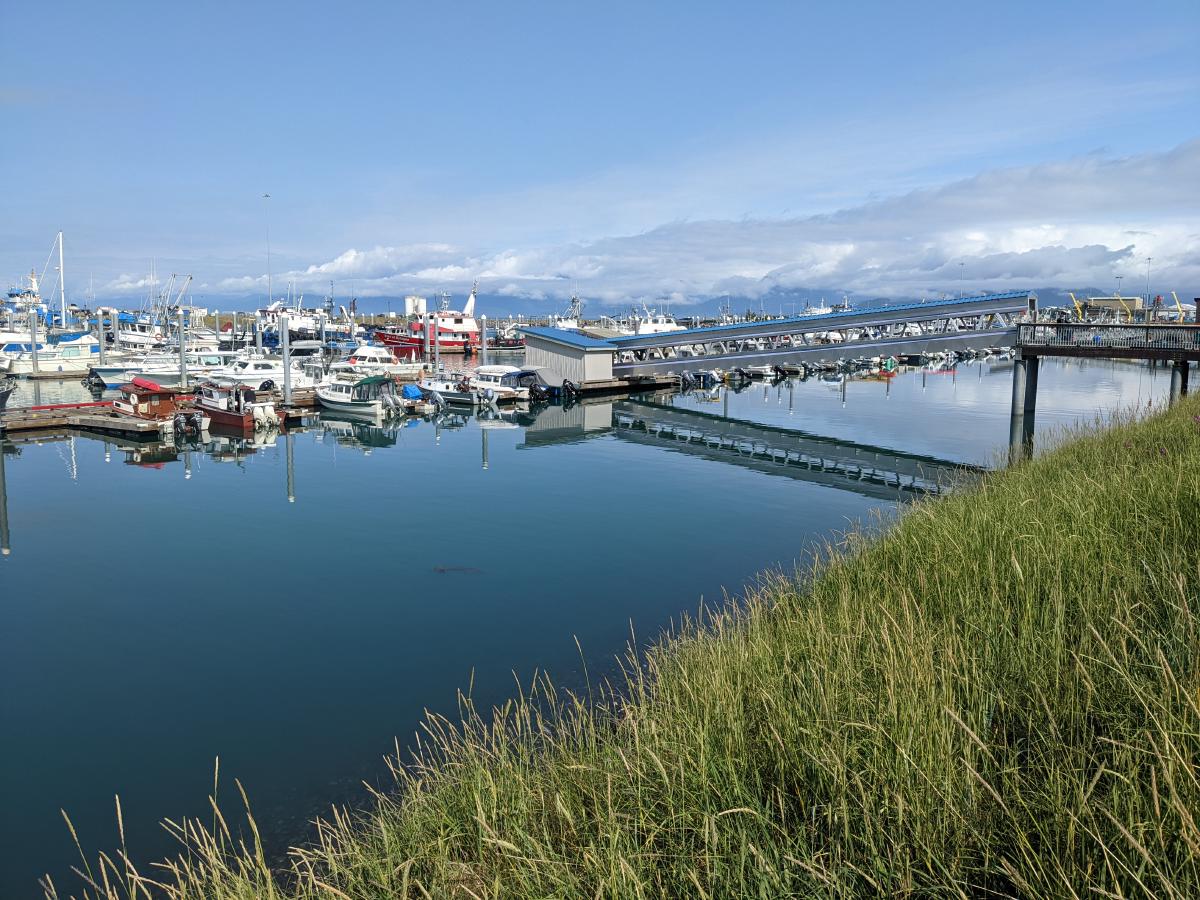
Anchor Point
On the drive to Homer, we stopped in at Anchor Point, the westernmost point on the US Highway System. If you’re in a motor vehicle and want to drive as far west as possible, this is where you end up. What’s crazy is that a huge portion of Alaska is still farther west - it’s just not connected by roads and requires boats or planes to access. The sky was smokey from some forest fires back in Lake Clark National Park, but on a clear day one can see at least 5 volcanoes.
Anchor Point, the westernmost point on the US Highway System. The lodge is still farther west across that water.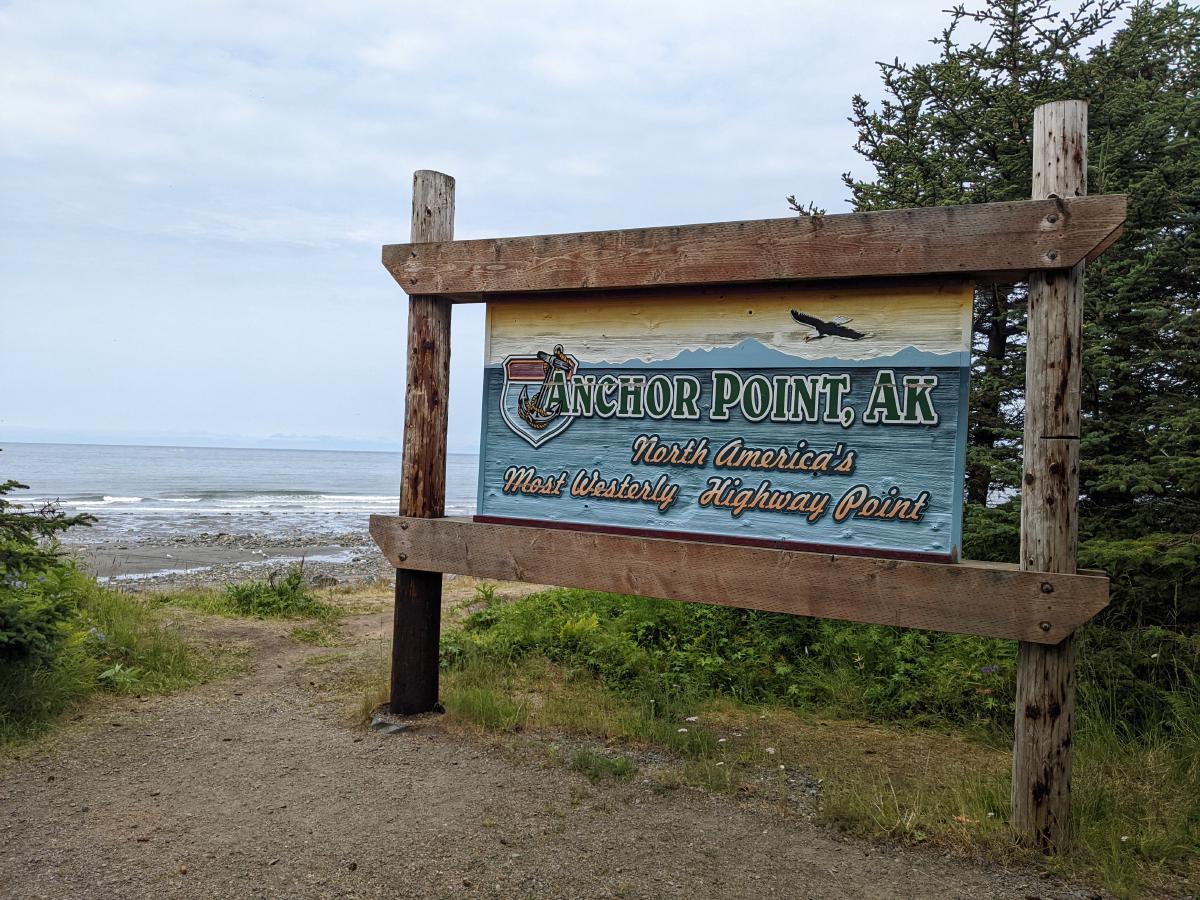
Alaska Islands and Ocean Visitor Center
Remember the puffins and that island they live on? Well, the visitor center for that refuge is all the way in Homer, and has free admission to their extensive exhibits on the coastal life of the area. We learned about the industry of trapping sea otters for their fur in the 1800s and how the population is slowly recovering. Alaska was hugely exploited for its natural resources (oil, fishing, furs, lumber, whales, gold and other minerals) but much of that is now being regulated in a very concentrated effort across political boundaries to preserve the state.
I didn’t take any pictures at the visitor center, so here is one taken from the end of the Spit.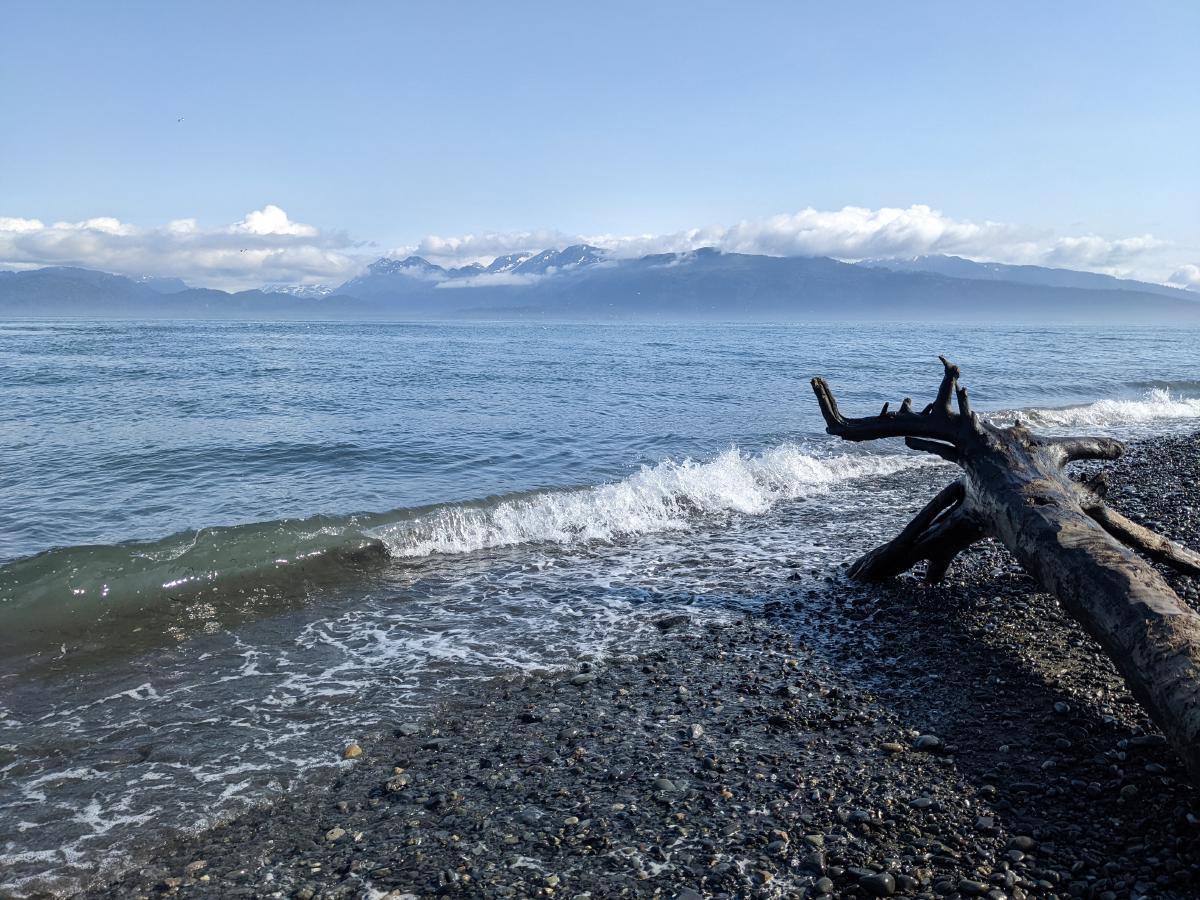
Pratt Museum
On our full day in Homer, we visited the Pratt Museum, a quintessential small-town history museum with impeccable curation, multimedia exhibits, and an incredible exhibition “Protection: Adaptation and Resistance” that highlighted Indigenous artists and how they adapt to the modern world during the pandemic and these turbulent political times.
We learned about the 1989 Exxon Valdez oil spill and how even though on the surface the oil appears to be cleaned up, just digging a few inches below the surface reveals residual oil. The spill impacted coastlines and water the equivalent of length of the coast of California and was disastrous for the local wildlife, fish, birds, and sea mammals. The most frustrating part to me is that Exxon claimed that they had plans in place for containment of a potential oil spill, yet it took over a day for containment teams to reach the site after first learning about the spill and by then it had spread much farther than could ever hope to be stopped. The most devastating effects could have been prevented had Exxon responded to the situation in a timely manner.
The “Protection: Adaptation and Resistance” exhibit is one of the best I’ve seen in my life. One highlight was a display of traditionally decorated masks that were designed to go over N95 masks. These were created to show that it is a point of Indigenous pride to care for ones community and to wear a mask to protect others. They had video calls during the pandemic lockdowns to continue passing down and teaching Indigenous crafts and traditions. It was inspiring to think about how the entire culture is built on the foundation of supporting one’s community, even at an inconvenience to oneself.
Please wear a mask, folks (especially an N95, KN95, or KF94). It’s a small inconvenience that could save a life and allows those who are especially vulnerable to participate in community life. It also protects you!
The Protection: Adaptation and Resistance exhibit was phenomenal and emotional. Decorative masks crafted to fit over medical face masks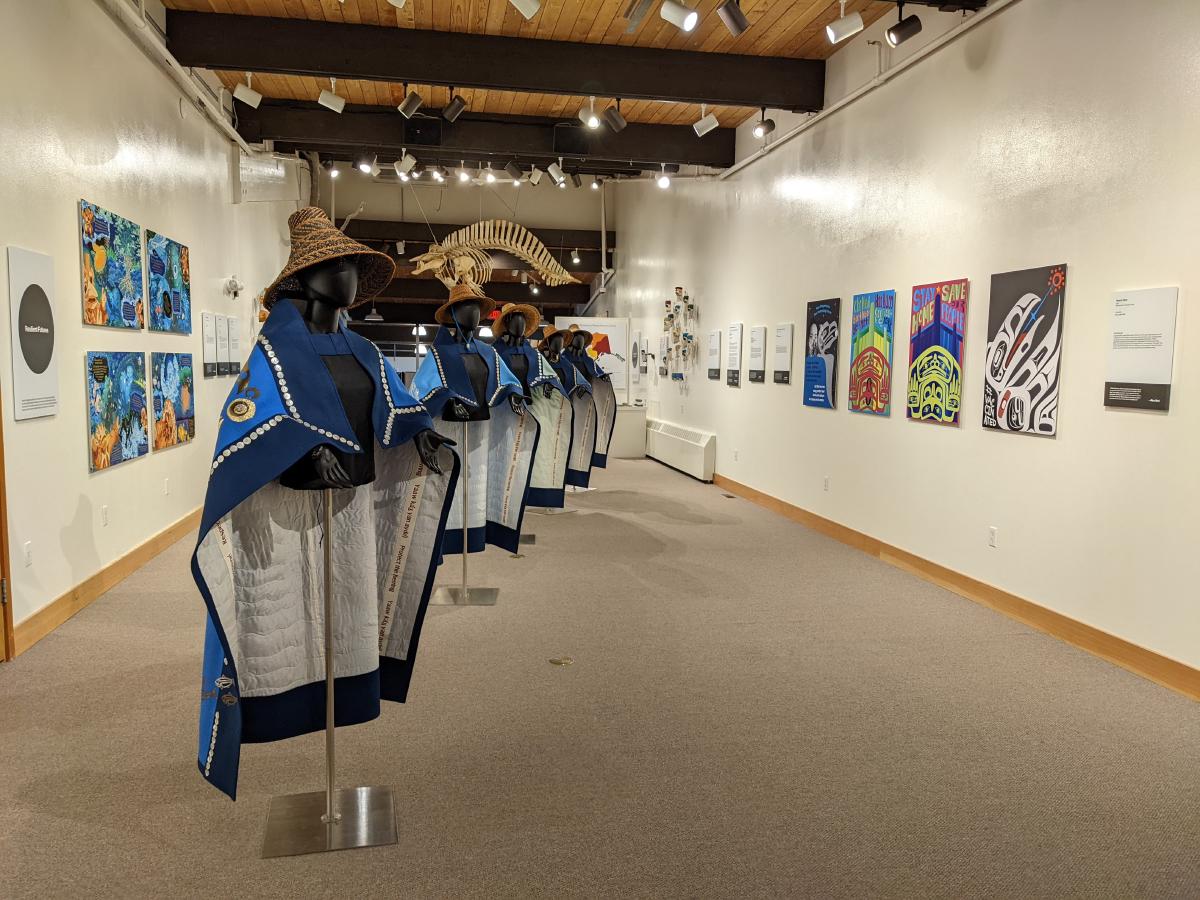
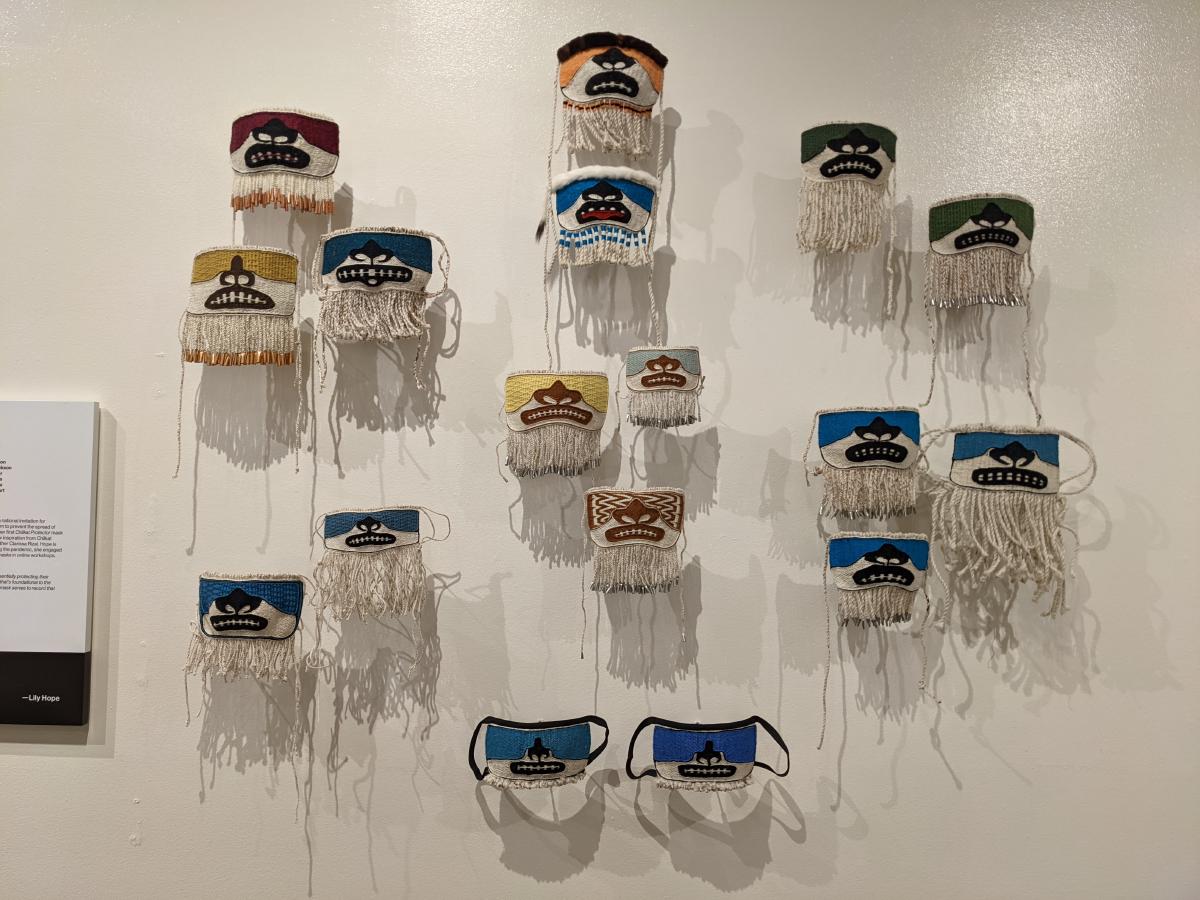
The Hunt for a Spit Rat (and stickers!)
Homer is also an artist community, and there are many quirky stores selling Indigenous crafts, apparel, pottery, and my personal favorite - stickers! Stickers are a great way for local artists to sell their art and gain recognition without a large upfront cost. I personally love them because they take up no space while traveling, but still let me have a physical memory from the trip. I like putting them on my water bottle so that it is always there to remind me of wonderful memories.
The smorgasbord of stickers I collected over the course of the trip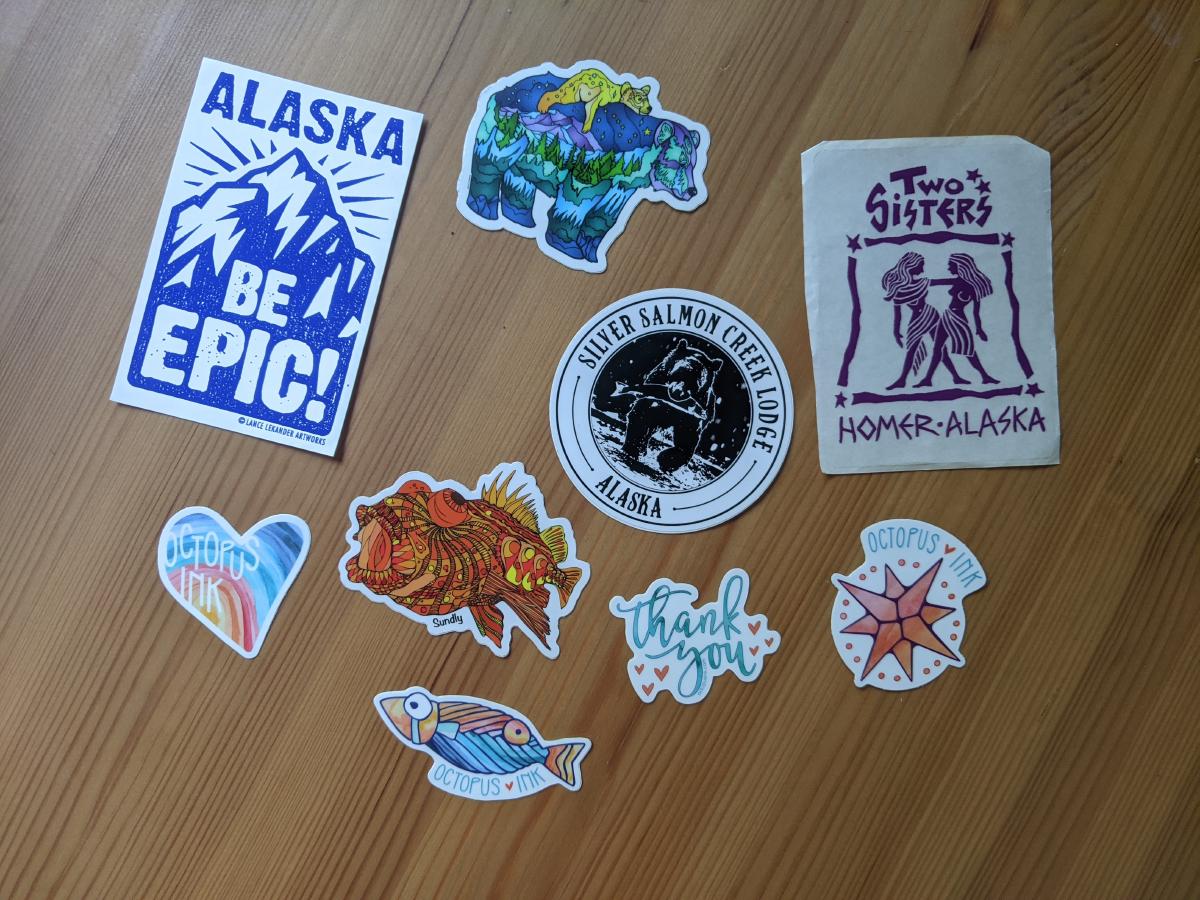
The last time I was in Homer (when I was eleven) I drank a delicious white hot chocolate drink called a Spit Rat. In reality it’s just steamed milk with Ghirardelli white chocolate powder, but at the time it was a child’s dream. I visited the place (a fishing charter company) where I remembered having the divine drink, but it no longer had barista services. I thought that I’d never relive my blissful childhood memory. However, on our last morning in Homer, Wild Edge Espresso obliged by making me a custom drink!
Our favorite stores were the Alaska Salt Co. which sells locally harvested salt, Two Sisters Bakery (an incredibly progressive women-owned bakery with divine pastries - we went here twice for breakfast!), and NOMAR, manufacturer and purveyor of handmade warm weather gear for extreme environments.
Biscuits and gravy, sticky buns, and other assorted pastries from Two Sisters Bakery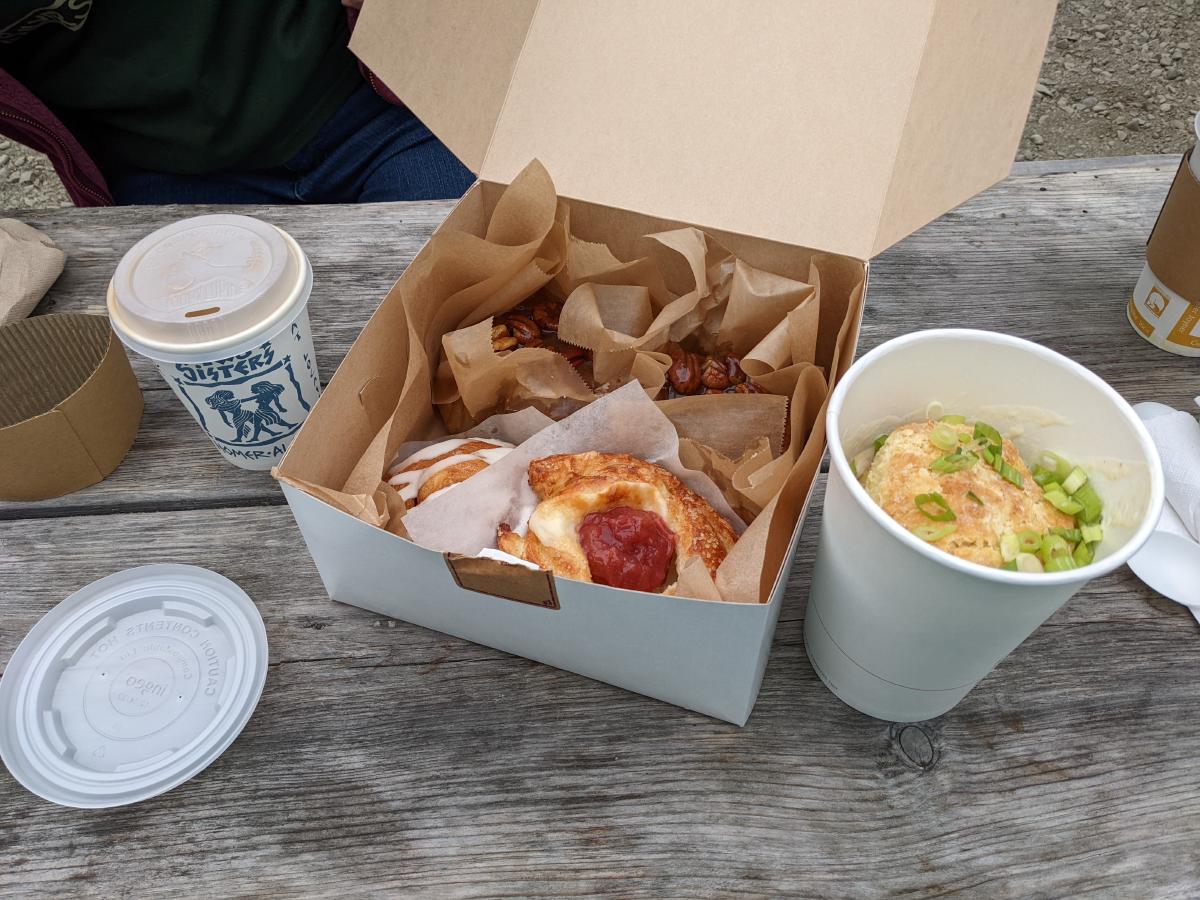
Seward
We drove to Seward, home to one of the northernmost ice-free ports in the United States (meaning that it doesn’t freeze over in the winter) and formerly an Alaska Gold Rush town from the 1890s. Much of Seward was destroyed in 1964 after a massive tsunami caused by an 8.4 earthquake rushed through the narrow bay. It has since been rebuilt, but one is always wary of tsunamis, volcanos, and earthquakes in this part of the world.
Alaska SeaLife Center
The Alaska SeaLife Center is a comprehensive non-profit aquarium that rescues and rehabilitates marine life. We saw weird fish, watched a feeding of the sea birds where they dove below the water, enjoyed the bumbling harbor seals and sassy sea lion, and dipped our hands into the ice-cold touch tank to feel starfish and sea anemones.
Laura touching critters in the freezing cold tank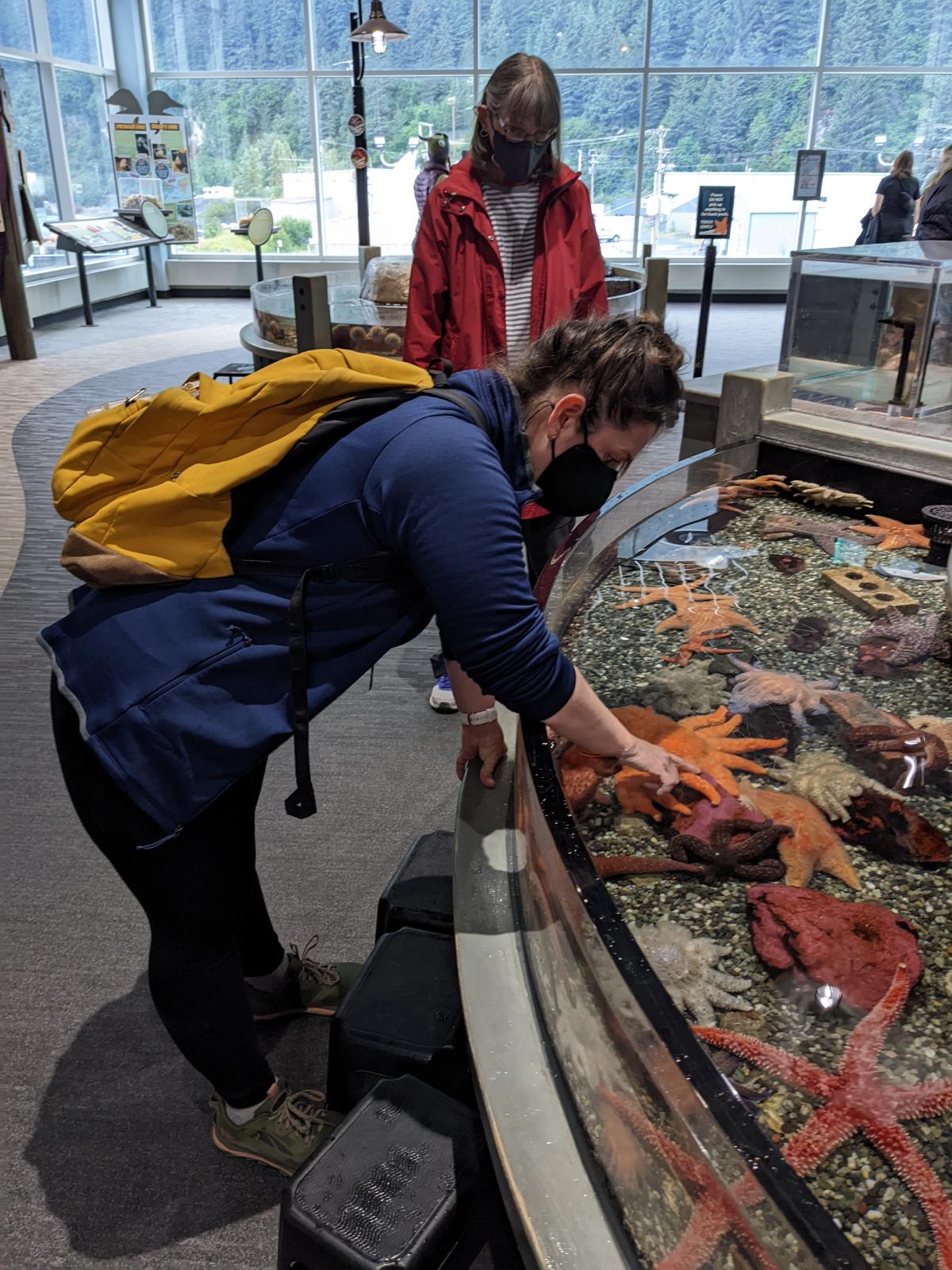
Kenai Fjords Cruise
Seward is the maritime gateway to Kenai Fjords National Park with daily cruises leaving Resurrection Bay and taking folks out to see glaciers, whales, the stunning coastline, sea birds, and other marine mammals. On an incredibly misty day (apparently this is par for the course in Alaskan summers) we set out on a six-hour cruise piloted by Captain Laura. We stopped at Spire Cove, an iconic National Geographic photography site, where Captain Laura expertly held the boat steady in between massive spires of rock.
Spire Cove in all its mist-shrouded glory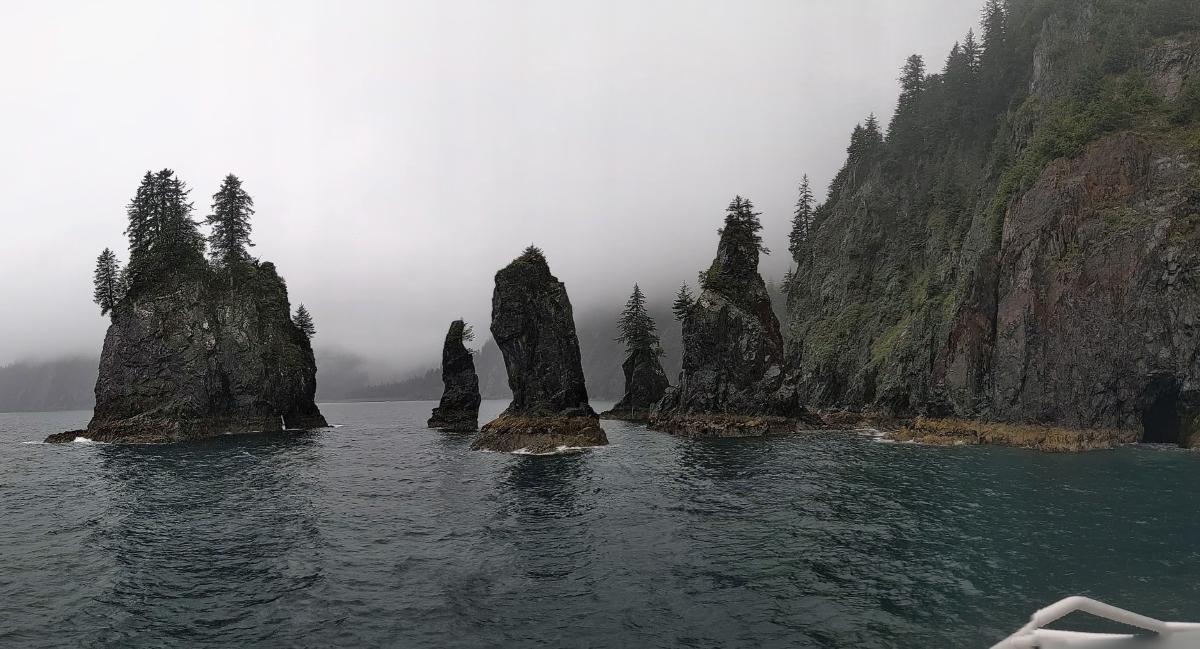
Captain Laura learned from another boat about a humpback whale, which we watched come up for air and dive deep, showing off its tail, before letting it go on its merry way. She then heard that there were orcas farther up ahead, so she sped off and took us to see the incredible sea mammals up close. The orcas came right up to the boat, and the mother orca even breached as a warning sign for her calf not to get too close!
The highlight of the trip was Aialik Glacier, a tidewater glacier that ends in Aialik Bay. It was a massive wall of jagged blue-white ice, constantly calving off pieces into the ocean that would become small icebergs. One of the guides even fished up a piece of crystal-clear glacial ice that had been compressed over millennia.
Images do not do this glacier justice. It’s so much bigger in person!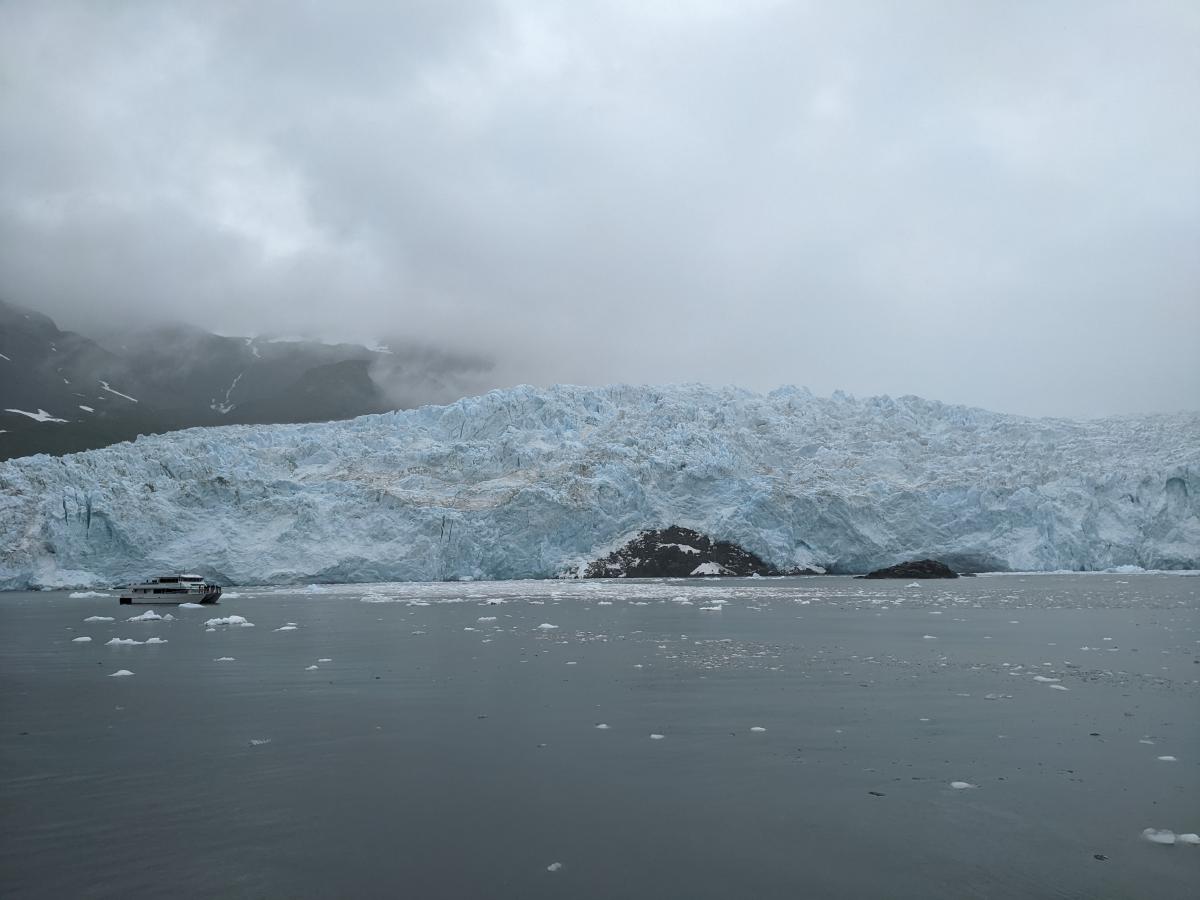
Check out how crystal clear this ice is!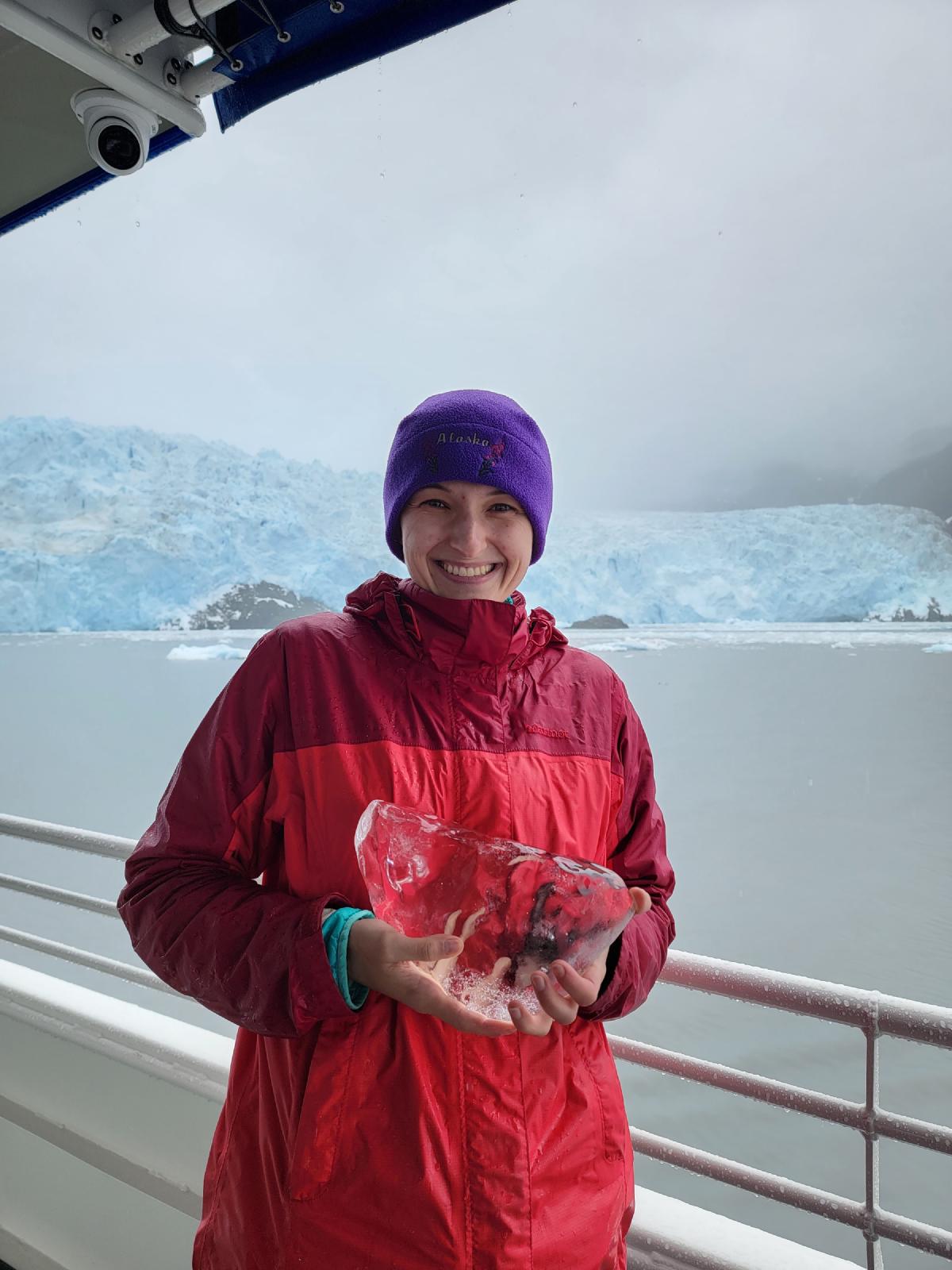
Over the course of the day, we also saw Steller sea lions, horned and tufted puffins, many seabirds, and sea otters. It was a rainy, wet, foggy, and cold day, but absolutely incredible.
Exit Glacier
After the cruise, we took advantage of how late it stays light in the Alaskan summer and drove to nearby Exit Glacier. This particular glacier has been recorded as retreating for over 200 years and provides a unique opportunity to see how glaciers sculpt a landscape. Glaciers are formed by layers of snow compressing over thousands of years to create dense ice, and they move under their own weight, scuffing the hillsides, pushing and polishing huge rocks and boulders, and carving channels into the terrain. Driving into the park, one sees signs posted at intervals marking the glacier’s position over the years, starting from 1815 up through 2010. Initially, the gaps between signs were quite long, but as we approached the visitor center the rate of retreat sped up rapidly. We hiked through the serene and quiet forest to the outwash plain (an area where the glacier deposits debris and grinds up the landscape over millennia), then up the rocky hills, passing the 2005 marker (approximately where the glacier reached when I last visited in 2004), then hiked even farther to the most recent marker from 2010.
A present-day image of the glacier in 2022, with a sign showing where it had reached in 2005 My mom and me looking out at the glacier from the same viewpoint in 2004 | Image courtesy of Dave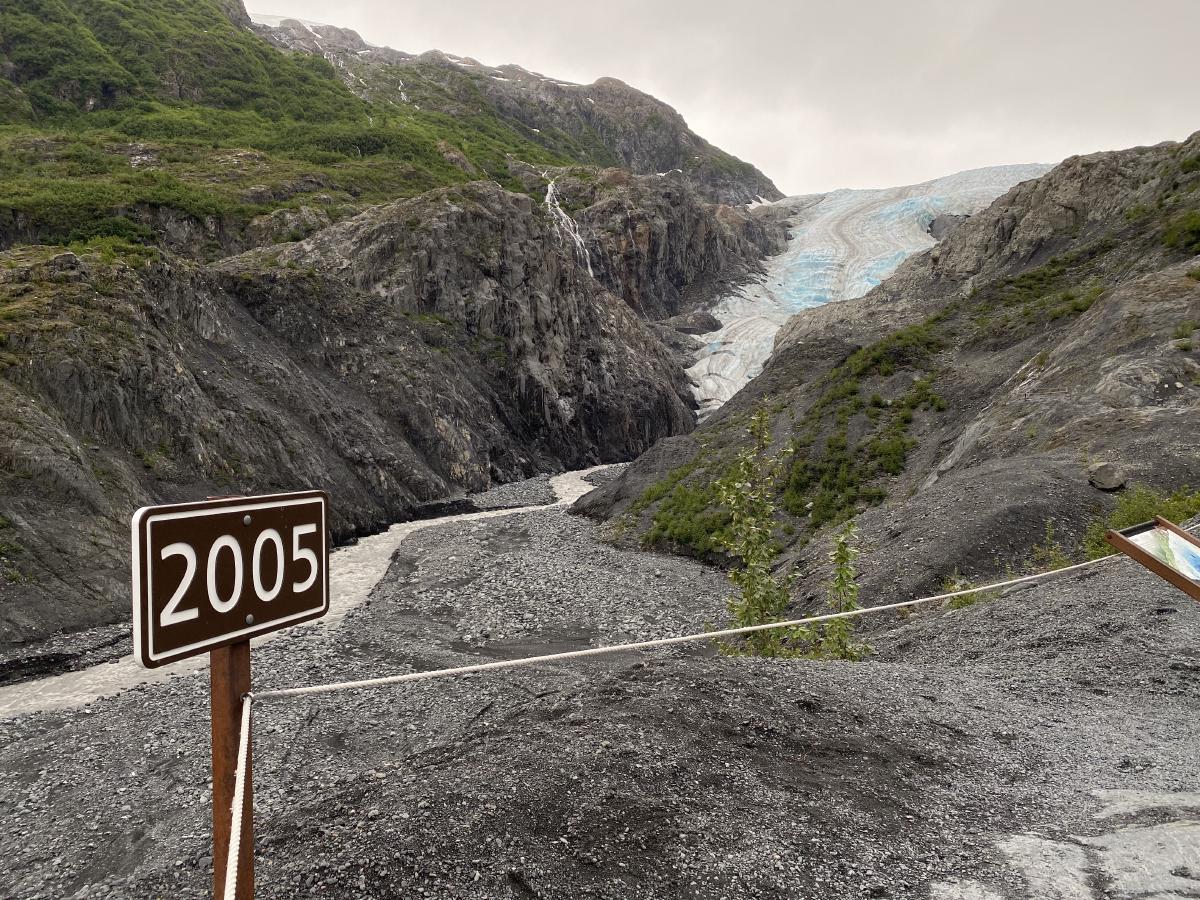
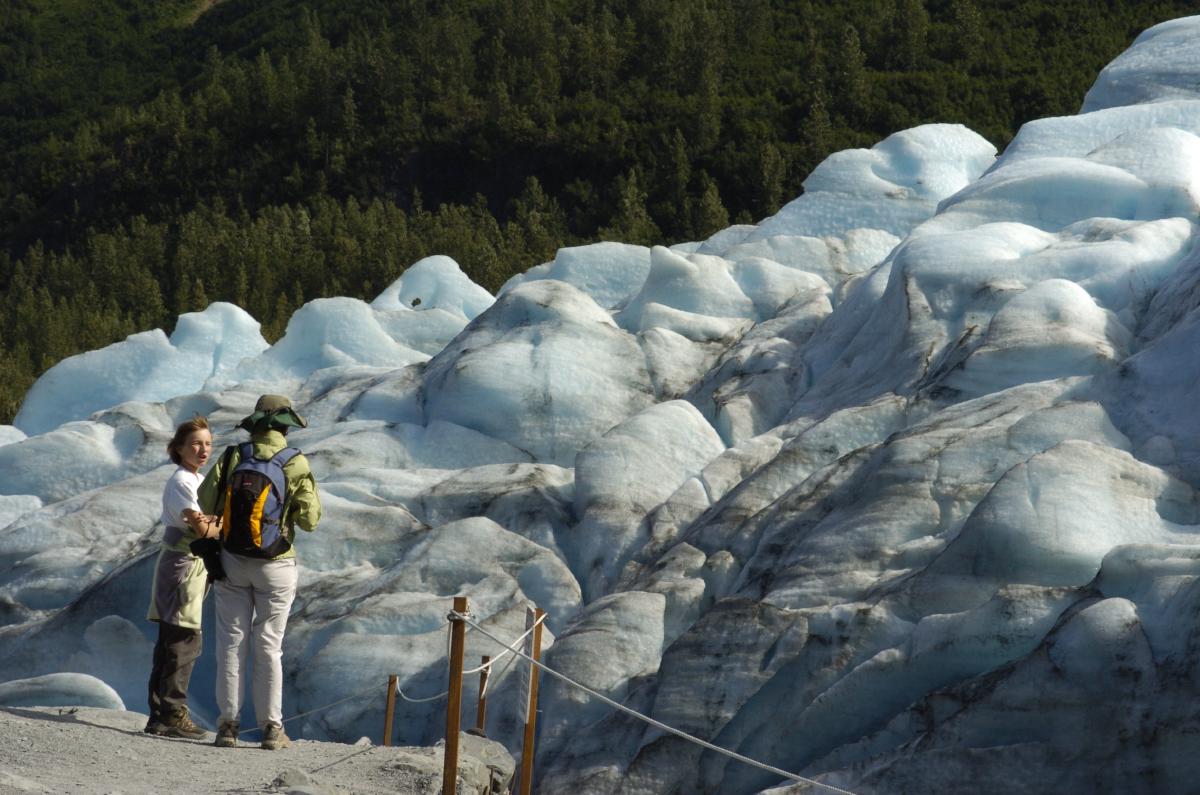
Who’s ready for fun story time? When I last visited Exit Glacier in 2004, my dad and I wanted to say we had stood on a glacier. To do so, we had to walk through a river of glacier melt (my feet have never been and hopefully will never be that cold again). My dad and I asked a nice person to take our picture as proof that we stood on the glacier (Mom stayed back and saw a moose in the meantime). We were so eager to warm up our feet that we didn’t check the photo until we had made it back across the river. Much to our dismay, our feet were cut off! Lesson learned. Now, I always check to make sure feet aren’t cut off in photos, and that the image looks okay before leaving the area.
This picture will haunt me for the rest of my life. | Image courtesy of Dave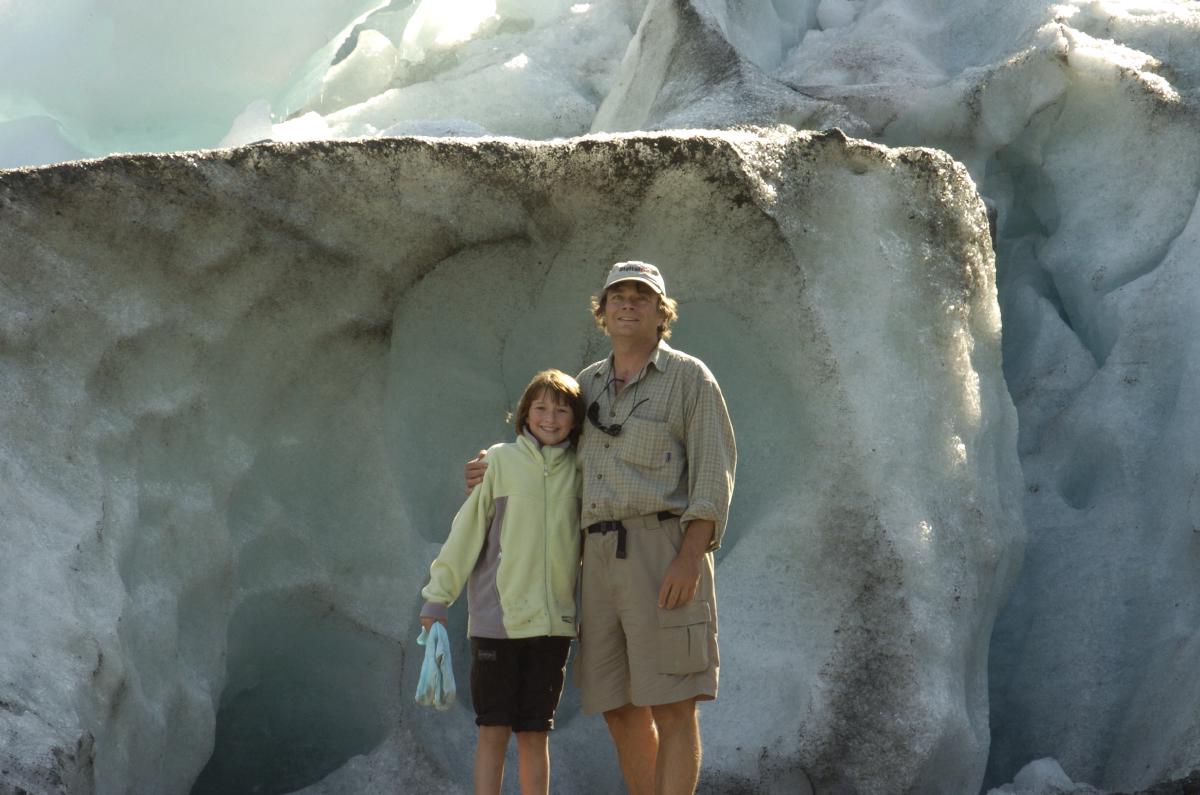
Now, it’s impossible to get that close to the glacier without crossing very dangerous terrain. Climate change is real, folks. We must act now before it’s too late.
On the way out of the park, we saw this stunning vista across the outwash plain. I love the purple color of the mountains.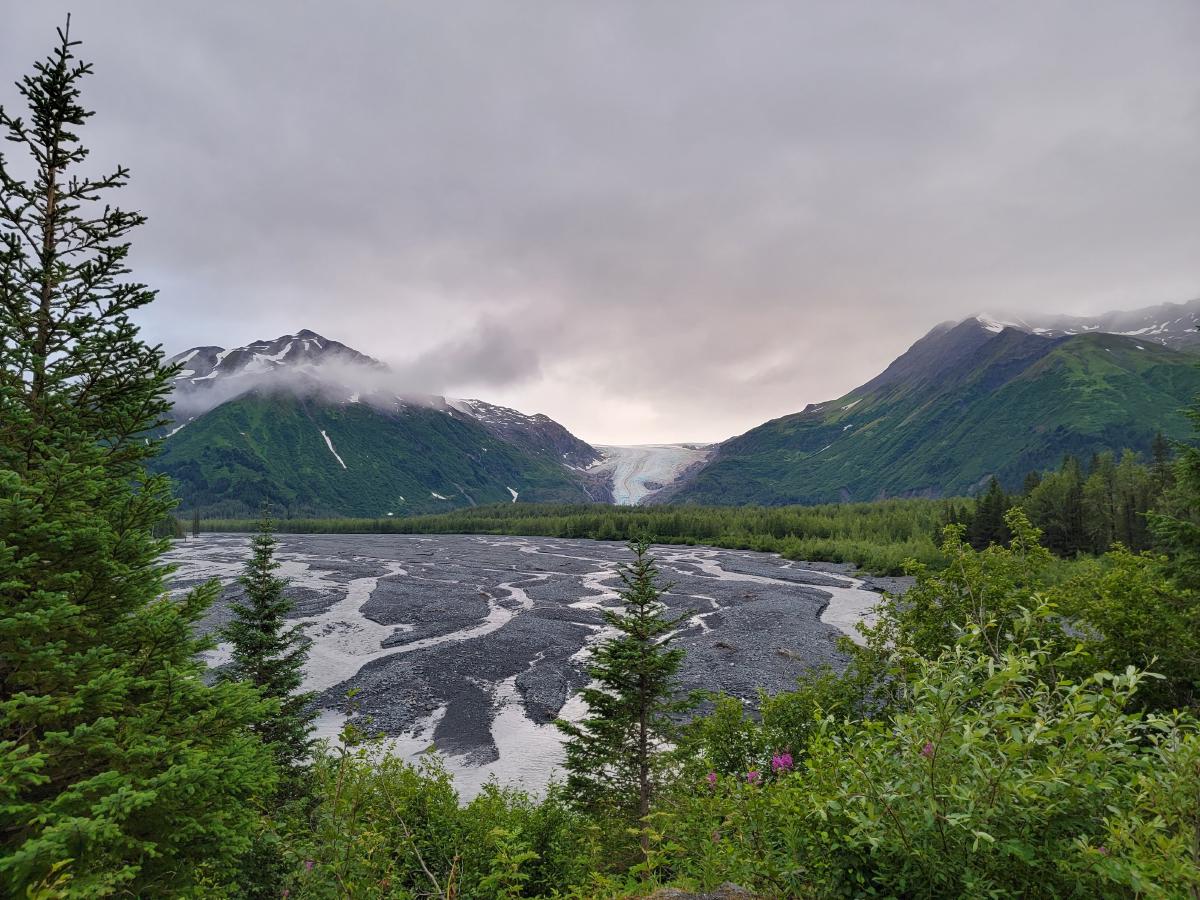
Back to Anchorage
We spent the final day of the trip in Anchorage where I bought some more stickers (including a cool artistic rendition of a rockfish), we ate a celebratory dinner of king crab, and we visited Earthquake Park, an area of land that slumped into the bay during the 1964 earthquake. A final brunch at Gwennie’s rounded out the trip as we headed back to the airport to fly home.
A final meal at Gwennie’s | Image courtesy of Glenn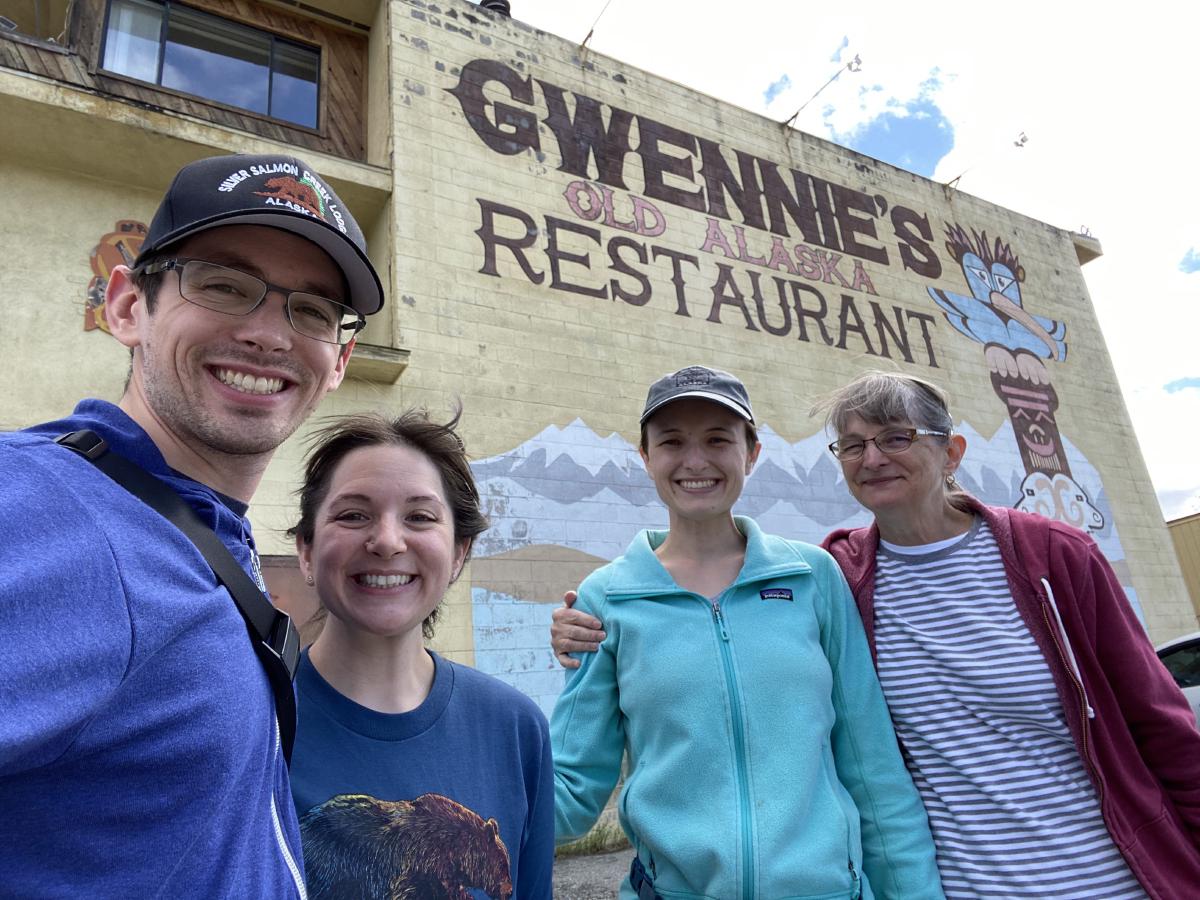
Staying Spontaneous
Alaska is such a beautiful, wild, and expansive state. Even the smaller mountains in between the major mountain ranges were taller than anything on the East Coast or in Texas. It’s difficult to convey the immense scale and size of this wonderful place. Be prepared for long drives (the state is huge!) and quickly changing weather (it ranged from 70F and sunny to 50F with a misty drizzle). Things are expensive in Alaska, as the short tourism season requires locals to make most of their yearly income in a limited time span. Also, if you haven’t noticed, Alaska is far from other populated areas, so it’s costly to transport goods to the state.
The all-day sunshine was a bit disorienting, but we loved knowing that we could spend our time without feeling the pressure of losing daylight. Bring an eye mask if light bothers you! Hotels usually have blackout shades, though.
Since Alaska’s tourism season is primarily limited to the summer because of the lengthy sunlight hours and tolerable temperature, it is very expensive and requires pre-booking the most important parts of the trip (hotels, lodges, day cruises). However, we were able to spontaneously visit museums, restaurants, and stores along the way, so our trip had a good mix. We visited by land and rented a car which provided the ability to control our visit and make changes, in comparison to a cruise with a set itinerary. However, I did really enjoy the days at the lodge where our meals and schedule were taken care of for us. It was quite relaxing to not be the one in charge of logistics for once!
Just a selfie with some bears, no big deal | Image courtesy of Glenn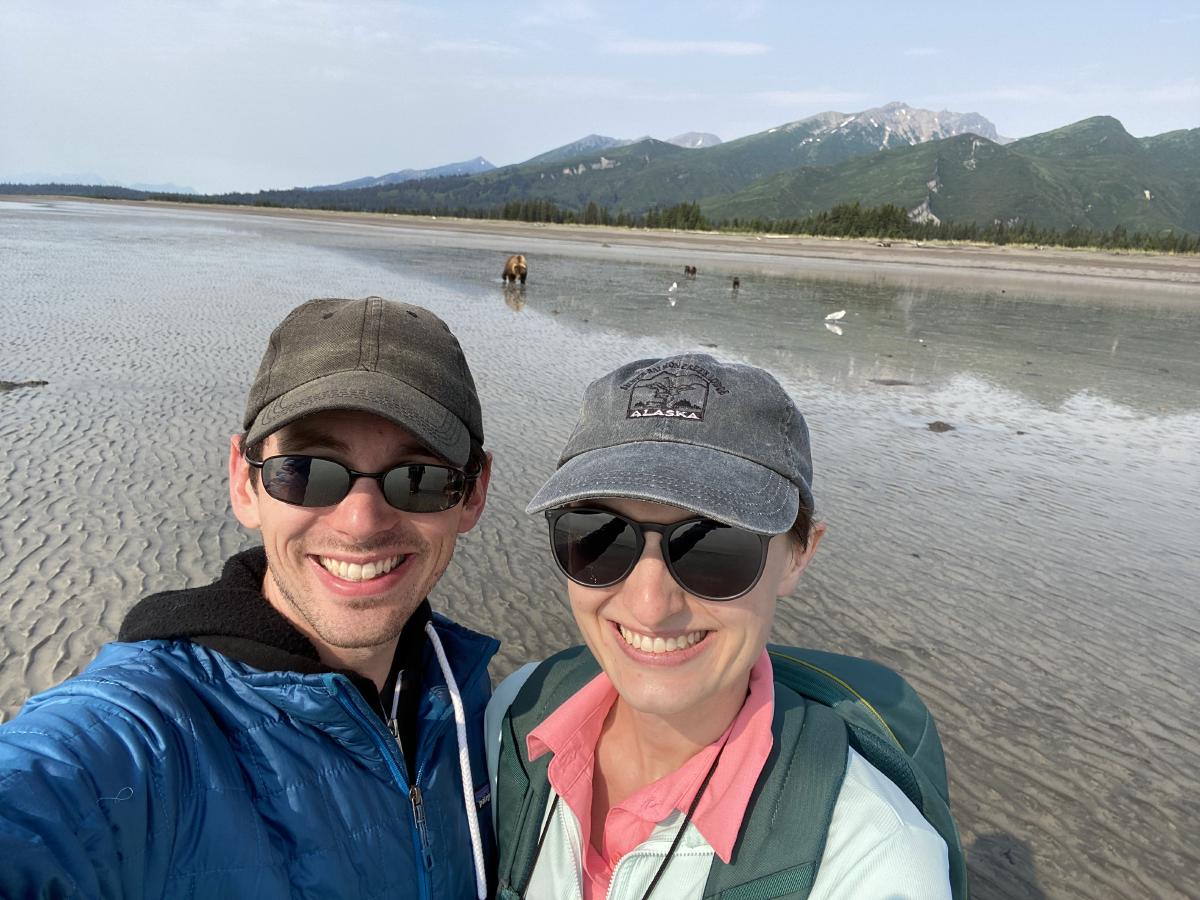
Conclusions
I enjoyed painting watercolors, as there were so many vibrant shades of green, blue, and purple from the trees and grass, water and sky, and mountainsides. I’ll share my sketchbook in another post soon once I add some final details.
Glenn and I also challenged ourselves to pack everything in personal item backpacks (mine is now 24L - smaller than a standard school backpack) and it was wonderful to travel so lightweight. Our new system involves removing all the packing cubes upon reaching lodging and then using the empty backpack as a daypack. It was so easy to grab our backpacks for anything - whether it be riding around in the trailer of an ATV or boarding small planes with a strict weight limit.
Glenn, Kathy, myself, and Laura with bears on the tidal flats | Image courtesy of Glenn
I was most impacted by Alaska’s culture of stewardship of the environment. This culture is shared between the native indigenous population and the Europeans and Americans who later colonized the state. The colonizers realized what the native peoples knew already - the environment is Alaska’s most important resource, and if it is exploited, it will no longer be there to support them. I was impressed at their dedication to conservation and understanding that Alaska’s wild beauty is the most important thing to preserve as it provides everyone’s livelihood. Every major industry in Alaska (tourism and exports) is dependent on the state’s natural resources so the government has made it a priority to preserve this. Since the state doesn’t have recycling (the population isn’t large enough to support it), they have prioritized compostable options for takeout, and have heavily regulated industries to ensure that they will be there in the future. Of course climate change is putting all of this at risk, but it was refreshing to see that the state government is united in preserving this, even across party lines.
If you have the opportunity to visit Alaska, by land or by sea, I highly recommend it. Take the time to learn about the animals, the environment, the Alaska Native culture, and the actions taken to preserve them. It’s so important to cultivate an appreciation for the environment, to feel discouraged at how it’s being destroyed, and then to feel optimistic that people are coming together to restore and preserve it. While climate change can’t be reversed, there is so much we still can do to save what’s left to create a brighter future. Find a way to get involved - I know I will!
Standing with the bear statue at Silver Salmon Creek Lodge | Image courtesy of Robb